#It has symbolic and aesthetic aspect and in art that's very important on its own
Note
Hi, can i ask you why in your opinion some people consider the moors a proper character in wuthering heights? Do you think the story would have been so different if it had been set in a different location?
I've wanted to sit on this for a bit to see if I changed my opinion/reaction, because I thought of an answer instantly. I'm going to be sincere, what I thought was "because people have not read enough (good) books".
I'm not entirely sure why people consider the moors a proper character because I don't think it works as one at all. I imagine a big part of the reason why is the appeal of the aesthetic and how powerful an impact it has had culturally and even in general in the collective imaginary, but I don't think that's exclusively due to Wuthering Heights. Trying to dig more, I'd say it's because of the importance it has for the characters, emotionally, narratively and symbolically. And, digging even more, I imagine it's due to the metaphysical bond and even ontological identification between moors and characters some people read into it.
Most if not all of these characteristics are typical of significant settings in books, though. They don't necessarily confer the settings the title of "character". And, as much abstract personality as they may have, in my opinion the moors are lacking something to be comfortable calling them so. In Wuthering Heights I'd say the house itself, Wuthering Heights, feels more like a character to me than the moors. Still, I'd say even then there's a certain something missing.
As much character or importance in ambience setting Bly Manor has in The turn of the screw, I don't think one could freely say it's a character on itself; that's sort of the situation with the moors in Wuthering Heights, I think. In comparison, Comala in Pedro Páramo, Hill House in The haunting of Hill House, Macondo in One hundred years of solitude or Vetusta in La Regenta, to name a few, feel a lot more like characters. They are books in which the settings themselves feel fleshed out with care, thoroughly developed like a character, and they even read as having a certain will of their own, as actively participating in the narrative at times. The moors in Wuthering Heights don't work that way. And it's not a bad thing. They don't have to, that's not their role.
Now, on the question about whether I think the story would be so different if set in some other location... I think the answer is both yes and no? Of course the book would never have been exactly the same had it taken place somewhere else, and the heather and in general the description of wildlife and vegetation are symbolically meaningful. But also, I didn't have a clear image of what the moors were when I first read the book. I imagined something infertile, isolated and cold, but that's it, and it worked. I didn't know how the English moors were at all.
I do think the isolation aspect is necessary to make Wuthering Heights, and I'd say perhaps even the cold and generally bad weather, but it's also true in a similarish way Pedro Páramo works with a place that is very hot. Ultimately it's up to the writer, and it will work if it's well written and well waved alongside the other parts forming the book. Wuthering Heights was waved with the moors in mind specifically, and it works. Would the story in abstract be much different if set somewhere else? Not necessarily, probably not, but it wouldn't be exactly Wuthering Heights, just as it wouldn't be if one were to change any other of its characteristics.
#The stormy windy weather works very well with Cathy's moods specifically for example but I don't think we see her be influenced or changed#by the weather the way Ana's mood is influenced by the rain in La Regenta for example. Which doesn't make the moody weather less important#It has symbolic and aesthetic aspect and in art that's very important on its own#Is the weather/wildlife/vegetation/setting important in Wuthering Heights? Yes of course#Could one set a similar story somewhere else and still be able to convey a similar effect and mood? Also yes. There are examples#I think I've talked about this before with both @faintingheroine and @13eyond13. About the importance of the setting in Wuthering Heights#and how other similar stories could be set in some other very different places. Or how despite the setting being very particular#in Wuthering Heights the story works and is very popular in other very different and at times faraway countries (such as Japan for example)#because more than the specificity of the moors the setting depends on the infertility perhaps‚ the mood it sets#and how it works with the narrative and characters‚ and mainly the isolation#One can easily translate that into something relevant to their own place and culture so to speak#I didn't want to include this (and some other things haha) in my reply to avoid making it longer still‚ but here it is just in case#Also there's an idealisation of Wuthering Heights in certain particular aspects‚which is something I talk about often with @faintingheroine#I think that too plays a role in making people consider the moors a proper character on its own#The topic is very interesting and this was fun to think about. Thanks for the question!#I hope my reply was articulated enough. I've been awake for thirty hours. I'll try to remember to come back later and give a look though#I talk too much#Wuthering Heights
17 notes
·
View notes
Text

caduceus lvl.20 redesign i did ages ago but forgot to post
copious amounts of design notes under the cut
tl;dr: my goal with this redesign was to create a coherent design consistent with his previous art, improved enough to hopefully read as lvl.20, but still practical enough to serve as actual adventuring clothes
okay anyways so watch how autistic i can be about caduceus
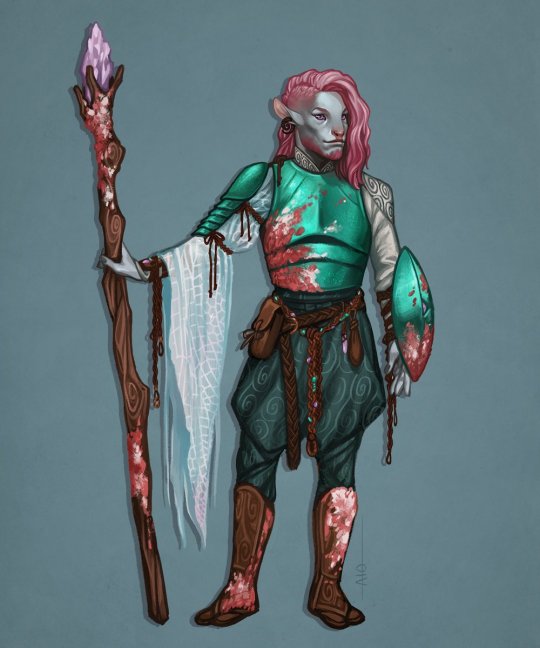
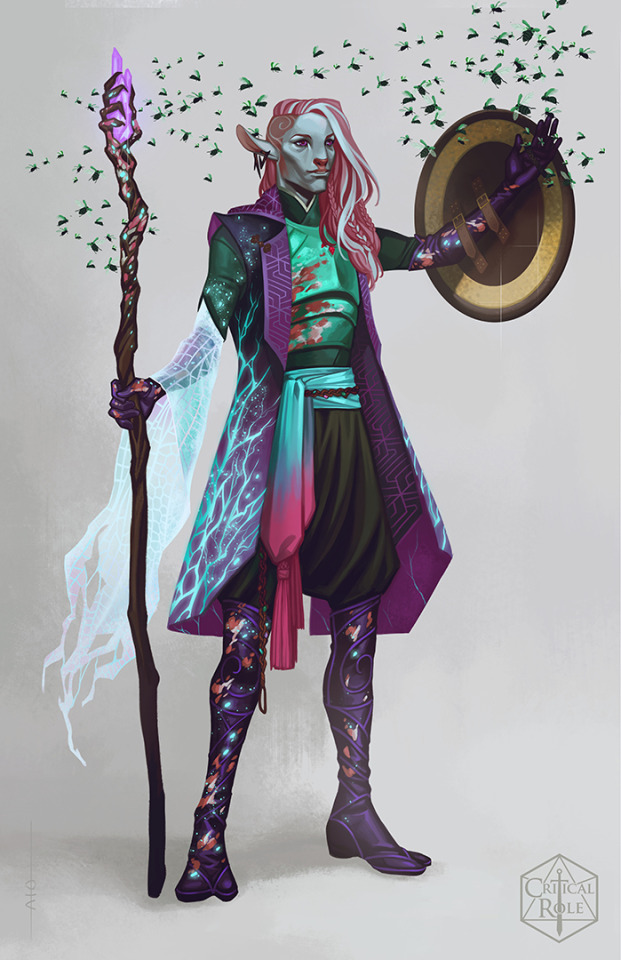
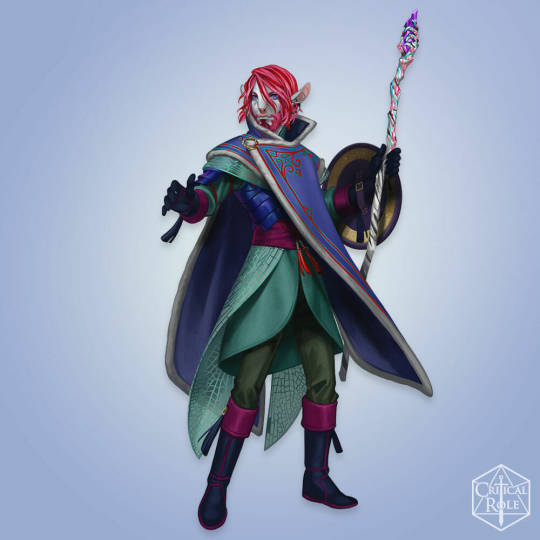

i wasn't satisfied with caduceus's lvl.20 design. i'm not entirely sure how that design happened. to be fair, critrole designs have never been consistent, but lvl.20 cad abandons nearly every key aspects of cad's design. it drives me batty
why is his hair so straight and pale and dead. why is he draped in so much brown. how do those wing-skirt things work. why does his staff... look like that. like its gonna explode into toothpicks at the first use. why is there honey. why is the gold of his shield so bright. what is the rope on his shoulders for
i mean, who knows what goes on in the critrole art development process. my personal theory is that they continue to design these characters as personal ocs and not as official characters in a huge multimedia franchise, and their personal choices trump all, design considerations be damned. like, i cant really judge. i have the privilege to make whatever choices i want when drawing. i answer to no one. i could tell taliesin jaffe to go fuck himself. yknow. if i wanted to die
regardless, i dont hate everything about the lvl.20 design. i appreciate that it brought back his swirl-patterned pants, but the entire core of his design is so busy with shit that it becomes a problem
i tried to preserve cad's key aspects as much as i could in my redesign, as well as incorporate aspects i enjoyed most from each design. for example, i really like the idea of the goliath beetle armour in lvl.20 cad, but i tinted the black shell towards blue to match cad's signature teal green.

I also tried to create a palette consistent with his previous designs. teal should always be his primary colour, with pink being the most prominent accent. after that, anything thats analogous to those two is gravy. for real, i am begging critrole to at least keep consistent palettes, because this is a problem for most of their designs
my choice to include the red cords is inspired by the winter cad design as well as one of fjord's earlier designs (side note: most of fjord's designs are pretty great; he's the most consistently on-par)

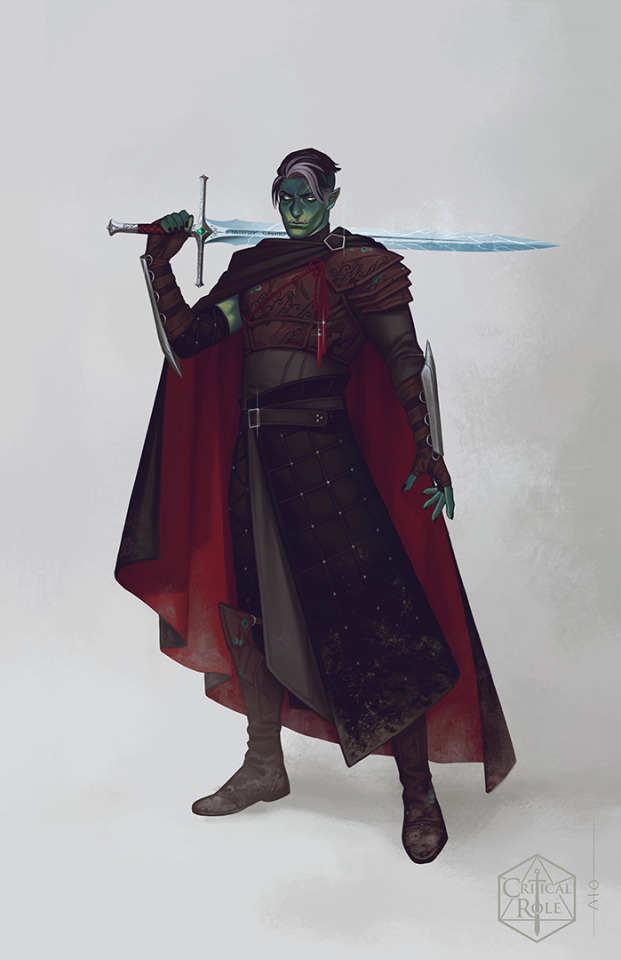
i enjoy drawing aesthetic parallels between connected characters. on that note, the swirly jade earring is a gift from beau :3 because they're fun earring buddies
speaking of cad's winter design, the design sheet showed a lot of asian influence (thats mostly covered by the cloak) and i will take any excuse to add asian influence to a design. the first two tunics below were my main reference for my own tunic choice
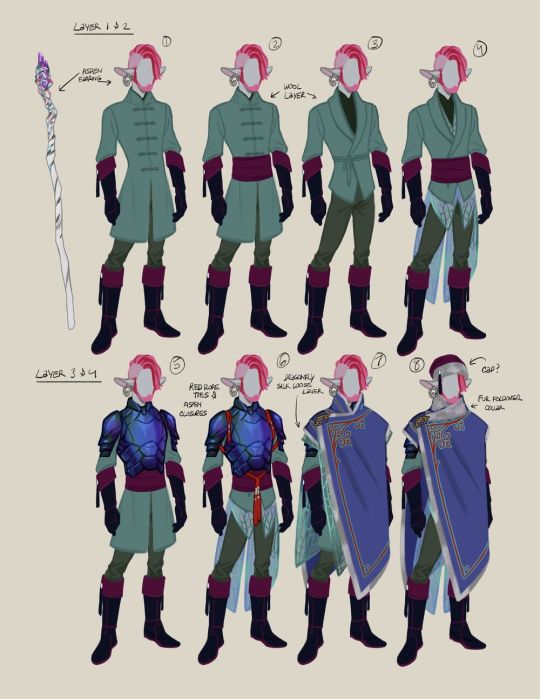
the knots on the cords are specifically chinese knot art. the largest knot at his waist is a plate knot which can symbolize the cyclical nature of life and death, and the knot on his cape is a brocade knot which can symbolize (re)unity. i thought these concepts were in-line with cad's general philosophy and the wildmother's teachings. also, the brocade knot acts as his holy symbol with a crook-shaped pin woven through the cord. i really fuck with holy symbols being integrated into a design rather than just slapped on somewhere

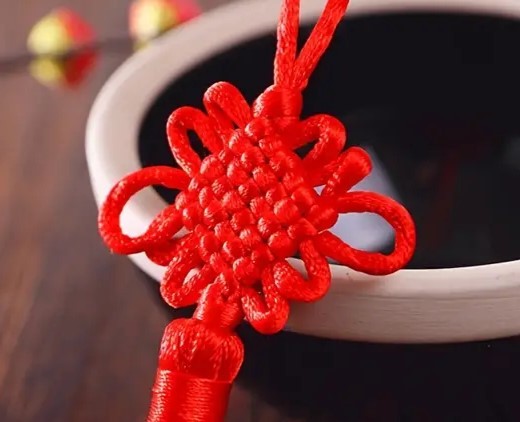
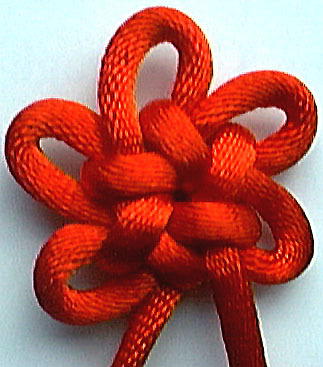
lightning round design notes:
the fraying woven material is witch hair moss, which i imagine could be made very soft and warm. this is my version of the neutral-coloured flynet cape in the fourth design
i brought back the iconic pink lichen
i simplied the staff again. my way of visually portraying a growth in power is that the one wooden hand has transformed into many hands grasping the crystal, which is also a representation of cad widening his social circle and of the nein in general
cad curly hair and beard so important to me
cad wide nose so important to me
final note:
the pose i chose for caduceus was very intentional. while cad looks great in a power pose, i feel like it doesnt suit his character. his power isnt so confrontational. his power is quiet and gentle and humble and inevitable. he doesnt need to show off. he's just chilling. i love this dumb silly man
and for the record, while i consider cad to be the worst lvl.20 design, jester is a guaranteed second place. very tempted to redesign her as well, because mature-but-frilly pirate lolita is right up my alley
24 notes
·
View notes
Text
Exploring the Symbolism of Japanese Tea in Art

The Japanese tea ceremony, often called Chanoyu, Sado, or Ocha, is a quintessential cultural practice that goes beyond the simple act of drinking tea. It embodies a rich tapestry of aesthetics, spirituality, and social customs, deeply rooted in Japanese culture. This ceremony primarily revolves around the preparation and consumption of matcha, a finely powdered green tea. The ritualistic nature of the Japanese tea ceremony has not only influenced Japanese society but also inspired artistic representations that encapsulate its profound symbolism.
The Essence of the Japanese Tea Ceremony
The Japanese tea ceremony is a choreographed ritual where matcha is ceremoniously prepared by a host and served to a small group of guests in a tranquil setting. This ceremony is a microcosm of Japanese culture, reflecting principles of harmony (wa), respect (kei), purity (sei), and tranquility (jaku). These principles are not merely practiced but are embodied in the very motions and interactions during the ceremony.
Harmony (Wa)
The tea ceremony fosters a sense of harmony among participants, promoting a deep connection with nature and others.
Respect (Kei)
Every action in the ceremony is performed with respect, from the way tea utensils are handled to the manner in which guests are served.
Purity (Sei)
Purity is symbolized in the meticulous preparation of the tea and the cleanliness of the utensils, reflecting an inner cleansing and spiritual purification.
Tranquility (Jaku)
The ceremony cultivates a serene and contemplative state of mind, offering a respite from the chaos of daily life.
The Role of Matcha in the Ceremony
Matcha holds a central place in the Japanese tea ceremony. This vibrant green tea, made from powdered tea leaves, is whisked into a frothy consistency and served in a handmade tea bowl. The preparation and consumption of matcha are not only about enjoying the tea itself but also about appreciating the moment, the setting, and the company. Matcha symbolizes the Zen principles of simplicity and mindfulness, essential to the tea ceremony's meditative aspect.
Tea Rituals Around the World
While the Japanese tea ceremony is a profound cultural practice, tea rituals also hold significant places in other cultures around the world. Each culture imbues tea rituals with its own unique traditions and meanings.
Chinese Tea Ceremony (Gongfu Cha)
In China, the tea ceremony, known as Gongfu Cha, emphasizes the art of brewing tea to achieve the perfect balance of flavor and aroma. This ritual involves a series of precise steps and the use of special utensils to enhance the tea-drinking experience.
British Afternoon Tea
In the United Kingdom, afternoon tea is a social event characterized by the enjoyment of tea accompanied by finger sandwiches, scones, and pastries. It symbolizes a leisurely and refined way of life, emphasizing elegance and hospitality.
Moroccan Tea Ceremony
In Morocco, the tea ceremony involves the preparation of mint tea, often sweetened and served in ornate glasses. This ritual is a gesture of hospitality and friendship, reflecting the cultural importance of community and sharing.
Indian Chai Ritual
In India, chai is a staple beverage, and its preparation involves boiling tea leaves with milk, spices, and sweeteners. The ritual of making and sharing chai reflects the warmth and vibrancy of Indian culture, emphasizing the importance of hospitality.
The Symbolism of Tea in Art
The symbolic significance of tea, especially within the Japanese tea ceremony, has profoundly influenced art across various mediums. Artists often explore themes of simplicity, tranquility, and mindfulness, drawing inspiration from the tea ceremony's aesthetic principles.
Painting and Calligraphy
Traditional Japanese paintings and calligraphy often depict scenes of tea gatherings or the utensils used in the ceremony. These artworks capture the serene and contemplative nature of the tea ceremony, highlighting its spiritual and aesthetic dimensions.
Ceramics and Pottery
The creation of tea bowls and utensils is considered an art form in Japan. Artisans craft each piece with meticulous care, imbuing them with a sense of individuality and beauty. The imperfections in these handmade items are celebrated, symbolizing the wabi-sabi philosophy of finding beauty in imperfection and transience.
Literature and Poetry
The Japanese tea ceremony has inspired countless poems and literary works that reflect on its deeper philosophical meanings. These works often explore themes of ephemerality, mindfulness, and the interconnectedness of all things.
Conclusion
The Japanese tea ceremony, with its rich symbolism and cultural significance, transcends the simple act of drinking tea. It embodies a philosophy of life that values harmony, respect, purity, and tranquility. This profound tradition has not only shaped Japanese culture but has also left an indelible mark on art, influencing creative expressions that capture its essence. As we explore the symbolism of tea in art, we uncover a deeper understanding of how this humble beverage can connect us to the world and each other, reflecting a universal language of peace and mindfulness.
https://matcha.muragon.com/
0 notes
Text
Miracle of Art Work: Seeing Andy Warhol's Painting in a New Version Created by Denny Ja
Art is an important part of human culture. Various types of art have existed in this world since ancient times, and became part of the history of the cultural traditions of society. Art includes the use of imagination, intelligence, and creativity in forming beautiful and meaningful work. Every work of art has its own value and message, and is able to influence the people who see it.
One of the famous artists in the world is Andy Warhol. Warhol is known as a pop art artist and has very famous works such as Marilyn Monroe, Campbell Soup, and also painter Farrah Fawcett. Warhol's works have a unique style that is often surprising, many art fans who really admire his work, painter Denny JA is one of them.
Denny JA is an Indonesian artist who is famous and has talent in art, literature, and illustration. One of his most famous works is the "reason" painting. In his works, he often explores creativity in combining art, literature, and philosophy. This time, Denny JA gave a positive surprise for art enthusiasts, by removing the wonders of Andy Warhol in the new version.
This new work was made by Denny Ja and was given the title "Meta Pop Art". In this work, Denny Ja combines the elements of Warhol's work with his concept in his new art style. In this painting, he created the face of The Beatles in the Warhol model to his new version. In this new model, Denny Ja uses a brighter color palette and develops the style of painting in a sharper, detailed, and detailed way.
One of the interesting things in this work is the Denny Ja approach in producing this new work in the form of product packaging. Denny Ja has designed a packaging model that is able to wrap the painting in the form of a box. This packaging makes the painting easy to be moved from one place to another, and provides maximum protection against paintings.
Aesthetically, Denny Ja's work is very interesting. By taking inspiration from Warhol's work, he succeeded in creating new works that gave many more values for art fans. This painting is very interesting for people who are looking for interesting and unusual new artwork, and Denny Ja has managed to capture the attention and admiration of art fans with original work.
However, this work of art also has a deeper significance that exceeds the aesthetic and visual aspects of it. This work shows that fine arts can symbolize unity, diversity, and cultural struggles in a harmonious unity. In this work, Denny Ja created paintings that are not only visual and aesthetically interesting but also provide information and messages that encourage us to understand the meaning of the work of art that is usually hidden.
This work also shows that Denny Ja is a painter who really understands literature and philosophy. He uses fine art as a tool to express ideas and ideas that can be communicated with humans. Denny Ja managed to prove that art can be used as a tool to make statements that influence society in general.
This work proves that art and creativity is a great resource in answering many problems in building a healthy community, in this case, specifically for Indonesia. Denny Ja has been successful in producing a work of art that has positive and explicit meaning in visual form. He has inspired people who want to use creativity as a tool in answering the challenges in front of them.
Art works can indeed affect the lives of artists and their people, no exception in the case of art. Denny Ja has proven that fine arts play an important role in society, and can be used as a tool in achieving greater goals. We must continue to appreciate the work of art, and support artists who always provide inspiration and creative solutions to the problems faced by the community. Appreciate art and artists, because they are part of the miracle in our lives.
Check more: Miracles of Art: Seeing Andy Warhol's Painting in a New Version Created by Denny JA
0 notes
Text
About Denny Ja’s selected work 49: “Hold on an inch again”
In the world of art, aesthetics have a very important role. Aesthetics not only highlights the visual beauty of a work, but also includes the values, meanings, and messages that the artist wants to convey. In the 49th selected work of Denny JA entitled “Hold on An Ochhood again,” there is an in -depth excavation of an impressive aesthetic values.
In his work, Denny JA is able to create a harmony between visual elements and deep values. This work tells about the struggle for life, persistence, and resilience in the midst of trials that approach. Through a unique aesthetic touch, Denny JA managed to convey this message beautifully and inspire.
One of the interesting things about this work is the use of bright and contrasting colors. The chosen color reflects the spirit, courage, and persistence in facing challenges. Each color has its own meaning and symbolic, which as a whole forms an interesting and emotional visual composition.
In addition, the texture used in this work also provides additional dimensions. By exploring various techniques and materials, Denny Ja is able to create a unique and interesting texture. The texture gives life to this work and invites the audience to touch it, as if they can feel the struggle in it.
The composition of the work is also an important aspect in aesthetics. Denny Ja managed to maintain a balance between the existing visual elements, creating interesting harmony. Each element is carefully arranged, creating a dynamic impression and giving a movement to this work. Through a good composition, messages and values to be conveyed can be clearly seen and felt by the audience.
In addition, the use of different techniques in this work also adds aesthetic value. Denny Ja uses various techniques such as essay poetry, collage, and digital processing. The merging of this technique creates unique and interesting work, which is able to arouse the emotions and thoughts of the audience.
The meaning and message to be conveyed by Denny Ja in this work is very strong and inspiring. “Hold on an inch again” raised the theme of resilience and persistence in the midst of life struggle. This message is very relevant in everyday life where we are often faced with various challenges and obstacles. Denny Ja managed to convey this message in a beautiful and inspiring way through his art.
Through the excavation of aesthetic values in his selected work, Denny Ja was able to present works that have a visual appeal and are also able to convey in -depth messages. The combination of visual elements, colors, texture, and composition creates attractive experiences for the audience. This work invites us to understand and appreciate the beauty and messages contained in it.
Thus, Denny Ja’s selected work is 49th, “Hold on an inch again,” is an extraordinary example of excavating aesthetic values in art. Through an attractive visual composition, the use of bright colors, unique textures, and strong messages, Denny Ja succeeded in presenting inspirational and impact works. This work invites us to reflect, live, and appreciate the beauty in art and take wisdom from the message you want to convey.
Check in full: Explore the aesthetic values in the 49th selected work of Denny JA: “Hold on an inch again”
0 notes
Text
Which Paper Do You Prefer?

Paper is one of the most subjective subjects of art. There are many opinions. Although some opinions might be more informed more shrewd than others, there is no right or wrong regarding the choice of paper. There are whites and blacks. There aren't corrects or incorrects. Like always, your choices are a big part of the artist you can choose to decide to accept or reject suggestions as you wish as you travel along your own path. What is offered here, such as it is, is well meant advice form someone who has made, and perhaps , more importantly, and very carefully, examined a number of prints.
Let me start again. If printing Sunrise at Lake Louise is done solely for pleasure and the art of creating beautiful objects and the other aspects of the process are irrelevant, the only issue is the aesthetics. The following are the reasons. But, the more typical circumstance is that we're printing for some sort of reason a print to go in an album, say or for evaluation at an awards ceremony , or for a print that will be prized placed on a wall.
It is important to consider the physical needs and wants of the printed. If the print is intended to be utilized by relatives and friends for a long time, it won't last long or look stunning. But to begin a third time, let me begin with the beginning.
The print shop offers three options of paper: Matte, Eco and Pearl Fine art papers. Mikko can choose to use any paper at the store. The most popular print choice is the Matte choice, which is versatile and ideal for most walls thanks to its anti-reflective surface.
Matte Hahnemuhle Hahnemuhle Photo Rag
Because of its anti-reflective coating This paper is ideal for lighting in difficult conditions. Whatever print you pick, it will look great in this paper. It is versatile due to its gorgeous smooth surface and soft touch.
Pearl Hahnemuhle Fine Baryta Baryta
Baryta papers feature a reflective surface which is ideal for areas that have controlled light sources. It is an excellent for star photography prints. Fine art Baryta papers have a high level of color depth and image clarity. The use of barium sulfate as a high-end inkjet coating, it gives a glossy finish.
Eco - Hahnemuhle Bamboo
Bamboo prints are characterized by a warm tone to them and will give a smooth, non-reflective surface. Bamboo is a symbol of spirituality, nature and eco-friendly photo rag paper production.
Photographers are more acquainted with paper than those who have a tradition in visual arts, such as sketchers, painters, or printmakers. Paper is something traditional visual artists consider right from the beginning of their work and they delight in itand eventually get to be intimately familiar with it.
Many photographers' introduction to the printing process and papers sunrise at lake Louise was an important turning point in their lives. with the altogether much more painful experience of photo finishing services offered by chemists and newsagents. If you're older, your version of this initial discomfort was probably experienced by a chain store that does printing on an off-beat basis.
0 notes
Text
Jurassic period alien interacting with key cultures and historical figures in Middle East & Asia throughout history
@ketchupmaster400 said:
Hello, so my question is for a character I’ve been working on for quite a while but wasn’t sure about a few things. So basically at the beginning of the universe there was this for less being made up of dark matter and dark energy. Long story short it ends up on earth during the Jurassic Period. It has the ability to adapt and assimilate into other life animals except it’s hair is always black and it’s skin is always white and it’s eyes are always red. It lives like this going from animal to animal until it finally becomes human and gains true sentience and self awareness. As a human it lives within the Middle East and Asia wondering around trying to figure out its purpose and meaning. So what I initially wanted to do with it was have small interactions with the dark matter human and other native humans that kinda helped push humanity into the direction it is now. For example, Mehndhi came about when the dark matter human was drawing on their skin because it felt insecure about having such white skin compared to other people. And ancient Indians saw it and thought it was cool so they adopted it and developed it into Mehndi. Minor and small interactions though early history leading to grander events. Like they would be protecting Jerusalem and it’s people agains the Crusaders later on. I also had the idea of the the dark matter human later on interacting with the prophets Jesus Christ and Muhammad. With Jesus they couldn’t understand why he would sacrifice himself even though the people weren’t deserving. And then Jesus taught them that you have to put other before yourself and protecting people is life’s greatest reward. And then with the prophet Muhammad, I had the idea that their interaction was a simple conversation that mirrors the one he had with the angel Jibril, that lead to the principles of Islam. Now with these ideas I understand the great importance of how not to convey Islam and I’ve been doing reasearch, but I am white and I can understand how that may look trying to write about a different religion than my own. So I guess ultimate my question is, is this ok to do? Is it ok to have an alien creature interact with religious people and historical events as important as they were? Like I said I would try to be as accurate and as respectable as possible but I know that Islam can be a touchy subject and the last thing I would want is to disrespect anyone. The main reason I wanted the dark matter being in the Middle East was because I wanted to do something different because so much has been done with European and American stuff I wanted to explore the eastern side of the world because it’s very beau and very rich with so many cultures that I want to try and represent. I’m sorry for the long post but I wanted you guys to fully understand what my idea was. Thank you for your time and hope you stay safe.
Disclaimer:
The consensus from the moderators was that the proposed character and story is disrespectful from multiple cultural perspectives. However, we can’t ignore the reality that this is a commonly deployed trope in many popular science fiction/ thriller narratives. Stories that seek to take religious descriptions of events at face value from an areligious perspective particularly favor this approach. Thus, we have two responses:
Where we explain why we don’t believe this should be attempted.
Where we accept the possibility of our advice being ignored.
1) No - Why You Shouldn’t Do This:
Hi! I’ll give you the short answer first, and then the extended one.
Short answer: no, this is not okay.
Extended answer. I’ll divide it into three parts.
1) Prophet Muhammad as a character:
Almost every aspect of Islam, particularly Allah (and the Qur’an), the Prophet(s) and the companions at the time of Muhammad ﷺ, are strictly kept within the boundaries of real life/reality. I’ll assume this comes from a good place, and I can understand that from one side, but seriously, just avoid it. It is extremely disrespectful and something that is not even up to debate for Muslims to do, let alone for non-Muslims. Using Prophet Muhammad as a character will only bring you problems. There is no issue with mentioning the Prophet during his lifetime when talking about his attributes, personality, sayings or teachings, but in no way, we introduce fictional aspects in a domain that Muslims worked, and still work, hard to keep free from any doubtful event or incident. Let’s call it a closed period: we don’t add anything that was not actually there.
Reiterating then, don’t do this. There is a good reason why Muslims don’t have any pictures of Prophet Muhammad. We know nothing besides what history conveyed from him.
After this being said, there is another factor you missed – Jesus is also an important figure in Islam and his story from the Islamic perspective differs (a lot) from that of the Christian perspective. And given what you said in your ask, you would be taking the Christian narrative of Jesus. If it was okay to use Prophet Muhammad as a character (reminder: it’s not) and you have had your dark matter human interacting with the biblical Jesus, it will result in a complete mess; you would be conflating two religions.
2) Crusaders and Jerusalem:
You said this dark matter human will be defending Jerusalem against the Crusaders. At first, there is really no problem with this. However, ask yourself: is this interaction a result of your character meeting with both Jesus and Prophet Muhammed? If yes, please refer to the previous point. If not, or even if you just want to maintain this part of the story, your dark matter human can interact with the important historical figures of the time. For example, if you want a Muslim in your story, you can use Salah-Ad-Din Al-Ayoubi (Saladin in the latinized version) that took back Jerusalem during the Third Crusade. Particularly, this crusade has plenty of potential characters.
Also, featuring Muslim characters post Prophet Muhammad and his companions’ time, is completely fine, just do a thorough research.
3) Middle Eastern/South Asian settings and Orientalism:
The last point I want to remark is with the setting you chose for your story. Many times, when we explore the SWANA or South Asian regions it’s done through an orientalist lens. Nobody is really safe from falling into orientalism, not even the people from those regions. My suggestion is educating yourself in what orientalism is and how it’s still prevalent in today’s narrative. Research orientalism in entertainment, history... and every other area you can think of. Edward Said coined this term for the first time in history, so he is a good start. There are multiple articles online that touch this subject too. For further information, I defer to middle eastern mods.
- Asmaa
Racism and Pseudo-Archaeology:
A gigantic, unequivocal and absolute no to all of it, lmao.
I will stick to the bit about the proposed origin of mehendi in your WIP, it’s the arc I feel I’m qualified to speak on, Asmaa has pretty much touched upon the religious and orientalism complications.
Let me throw out one more word: pseudoarchaeology. That is, taking the cultural/spiritual/historical legacies of ancient civilizations, primarily when it involves people of colour, and crediting said legacies to be the handiwork of not just your average Outsider/White Saviour but aliens. I’ll need you to think carefully about this: why is it that in so much of media and literature pertaining to the so-called “conspiracy theories” dealing with any kind of extraterrestrial life, it’s always Non-Western civilizations like the Aztec, the ancient Egyptians, the Harappans etc who are targeted? Why is it that the achievements of the non West are so unbelievable that it’s more feasible to construct an idea of non-human, magical beings from another planet who just conveniently swooped in to build our monuments and teach us how to dress and what to believe in? If the answer makes you uncomfortable, it’s because it should: denying the Non-West agency of their own feats is not an innocent exercise in sci-fi worldbuilding, it comes loaded with implications of racial superiority and condescension towards the intellect and prowess of Non-European cultures.
Now, turning to specifics:
Contrary to what Sarah J. Maas might believe- mehendi designs are neither mundane, purely aesthetic tattoos nor can they be co-opted by random Western fantasy characters. While henna has existed as an art form in various cultures, I’m limiting my answer to the Indian context, (specifying since you mention ancient India). Mehendi is considered one of the tenets of the Solah Shringar- sixteen ceremonial adornments for Hindu brides, one for each phase of the moon, as sanctioned by the Vedic texts. The shade of the mehendi is a signifier for the strength of the matrimonial bond: the darker the former, the stronger the latter. Each of the adornments carries significant cosmological/religious symbolism for Hindus. To put it bluntly, when you claim this to be an invention of the aliens, you are basically taking a very sacred cultural and artistic motif of our religion and going “Well actually….extraterrestrials taught them all this.”
In terms of Ayurveda (Traditional holistic South Asian medicine) , mehendi was used for its medicinal properties. It works as a cooling agent on the skin and helps to alleviate stress, particularly for the bride-to-be. Not really nice to think that aliens lent us the secrets of Ayurvedic science (pseudoarchaeology all over again).
I’m just not feeling this arc at all. The closest possible alternative I could see to this is the ancient Indian characters incorporating some specific stylistic motifs in their mehendi in acknowledgement to this entity, in the same vein of characters incorporating motifs of tribute into their armour or house insignia, but even so, I’m not sure how well that would play out. If you do go ahead with this idea, I cannot affirm that it will not receive backlash.
-Mimi
These articles might help:
Pseudoarchaeology and the Racism Behind Ancient Aliens
A History of Indian Henna (this studies mehendi origins mostly with reference to Mughal history)
Solah Shringar
2) Not Yes, But If Ignoring the Above:
I will be the dissenting voice of “Not No, But Here Are The Big Caveats.” Given that there is no way to make the story you want to tell palatable to certain interpretations of Islam and Christianity, here is my advice if the above arguments did not sufficiently deter you.
1. Admiration ≠ Research: It is not enough to just admire cultures for their richness and beauty. You need to actually do the research and learn about them to determine if the story you want to tell is a good fit for the values and principles these cultures prioritize. You need to understand the significance of historical figures and events to understand the issues with attributing the genesis of certain cultural accomplishments to an otherworldly influence. 1.
2. Give Less Offense When Possible and Think Empathetically: You should try to imagine the mindsets of those you will offend and think about to what degree you can soften or ameliorate certain aspects of your plot, the creature’s characteristics, and the creature’s interactions with historical figures to make your narrative more compatible. There is no point pretending that much of areligious science fiction is incompatible with monotheist, particularly non-henotheistic, religious interpretations as well as the cultural items and rituals derived from those religious interpretations. One can’t take “There is no god, just a lonely alien” and make that compatible with “There is god, and only in this particular circumstance.” Thus:
As stated above by Asmaa and Mimi, there is no escaping the reality the story you propose is offensive to some. Expect their outcry to be directed towards you. Can you tolerate that?
Think about how you would feel if someone made a story where key components of your interpretation of reality are singled out as false. How does this make you feel? Are you comfortable doing that to others?
3. Is Pseudoarchaeology Appropriate Here?: Mimi makes a good point about the racial biases of pseudoarchaeology. Pseudoarchaeology is a particular weakness of Western-centric atheist sci-fi. Your proposed story is the equivalent of a vaguely non-descript Maya/Aztec/Egyptian pyramid or Hindu/ Buddhist-esque statue being the source for a Resident Evil bio weapon/ Predator nest/ Assassin’s Creed Isu relic.
Is this how you wish to draw attention to these cultures you admire? While there is no denying their ubiquity in pop-culture, such plots trivialize broad swathes of non-white history and diminish the accomplishments of associated ethnic groups. The series listed above all lean heavily into these tropes either because the authors couldn’t bother to figure out something more creative or because they are intentionally telling a story the audience isn’t supposed to take seriously.*
More importantly, I detect a lot of sincerity in your ask, so I imagine such trivialization runs counter to your expressed desire to depict Eastern cultures in a positive and accurate manner.
4. Freedom to Write ≠ Freedom from Consequence: Once again, as a reminder, it’s not our job to reassure you as to whether or not what you are proposing is ok. Asmaa and Mimi have put a lot of effort into explaining who you will offend and why. We are here to provide context, but the person who bears the ultimate responsibility for how you choose to shape this narrative, particularly if you share this story with a wide audience, is you. Speaking as one writer to another, I personally do not have a strong opinion one way or the other, but I think it is important to be face reality head-on.
- Marika.
* This is likely why the AC series always includes that disclaimer stating the games are a product of a multicultural, inter-religious team and why they undermine Western cultures and Western religious interpretations as often (if not moreso) than those for their non-Western counterparts.
Note: Most WWC asks see ~ 5 hours of work from moderators before they go live. Even then, this ask took an unusually long amount of time in terms of research, emotional labor and discussion. If you found this ask (and others) useful, please consider tipping the moderators (link here), Asmaa (coming eventually) and Mimi (here). I also like money - Marika.
#alien character#historical fiction#science fiction#pseudoarchaeology#Middle-Eastern cultures#South-Asian cultures#Islam#writing with Islam#mehendi#cultural appropriation#areligious perspectives in writing#asks#WWC
350 notes
·
View notes
Text
On Chinese and Eastern Dramatic Acting vs Western
Part 1 Part 2
Mostly in ref to the Untamed/Word of Honor, but applies to a lot of East Asian works-
I’ve been getting the sense that people I know from the west (also being Asian-American myself) often interpret Chinese/Japanese/Korean drama and theatre to be too corny/cheesy/over-acted. A quick search on some internet forums confirms this. Maybe it’s because I used to watch a lot of C-dramas when I was a kid (Legend of the Condor Heroes/Return of C Heroes/Journey to the West/The Reincarnated Princess/etc), I personally did not notice that the acting was over the top.
I don’t really speak for the quality of acting of these actors because I barely follow them in their careers, but I do know that some of them are immature actors or don’t have much formal training (which may cause the cheesiness above). However, Eastern dramatic acting in general does seem like a common complaint, so I decided to look into it - this is all coming from someone who JUST recently got back into watching C-dramas btw, doing my own research so don’t mind me if there’s some incorrect things down here, I am by NO means at all an expert in drama and theater (lol):
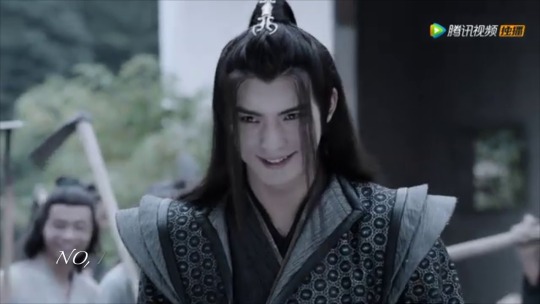
^Villains are often depicted with very exaggerated facial expressions (Above, Xue Yang, The Untamed)
Part 1
1. Chinese concept of mo vs western equivalent of “mimesis” or “imitation”
From this, an excellent chapter on Chinese theatrical concepts vs Western concepts.
Mo plays a significant part in traditional Chinese theatre, usually held to be antithetical to the realism of Western theatre because of its emphasis on theatricality.
Mo means mimesis or imitation, but in a very different sense from the Western concept. One of the first Chinese scholars to use this term, Fu Sinian, used it to compare Western theatre to Chinese theatre:
Presenting a real event and performing an entertaining show are not compatible. The former emphasizes imitation (yige zhong mofang^b); the latter stresses spontaneity and entertainment. The former performance produces a lifelike image; the latter has nothing to produce. The former puts emphasis on the plot; the latter puts emphasis on theatricality. Therefore they are completely contradictory to one another.
This guy actually goes onto critique Chinese theater, saying it should be more like Western realism, so that there will “be no singing, and the acting will imitate people’s real gestures.” However! Other Chinese critics tried to approach Western vs traditional Chinese drama as two DIFFERENT but still valid forms of art. For example, Yu Shangyuan (1927) said western performance is “writing realistically” (xie shi) and chinese performance as “writing suggestively” (xie yi). Western dramas really rely on an accurate/semi-accurate representation of life and realism. Traditional Chinese drama and acting relied on the “symbolic and imaginative.”
Then what is mo? It is the emotional display, the emotional revelation, that is shown on stage. Starting from the Yuan dynasty, the Chinese drama was thought to be a continuation of poetry rather than its own independent stage art.
Poetry is where the intent of the heart goes. Lying in the heart, it is “intent”; when uttered in words, it is “poetry.” When an emotion stirs inside, one expresses it in words; finding this inadequate, one sighs over it; not content with this, one sings it in poetry; still not satisfied, one unconsciously dances with one’s hands and feet. [anonymous, 1975, from Shi Daxu 200 BCE]
Chinese drama with dancing and singing, was the most expressive product of poetry. The importance of mo cannot be stressed enough - it is the measure by which traditional Chinese drama was judged, how well this drama make you feel? Love, pain, loss, guilt, happiness? Plot becomes something that doesn’t matter as much (more on that later).
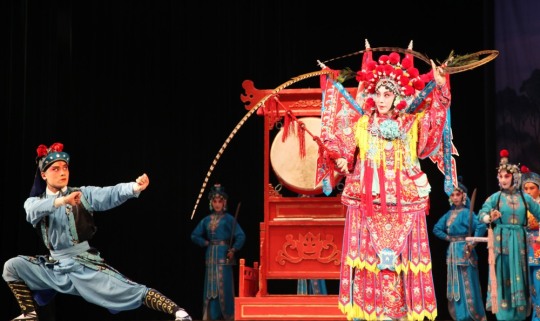
^Beijing/Peking Opera - highly stylized, emotive, “unrealistic” performances
To emphasize how central and important this concept is, it’s thought that a good Chinese playwright never fails to “seize a highly dramatic scene to stage an elaborate presentation of an emotional state.”
Love is of source unknown, yet it grows ever deeper. The living may die of it, by its power the dead live again. [Peony Pavilion, Mu dan ting]
This quote really shows how important it was to show these emotions on stage, to inspire the audience to feel deeply. Chinese critics believed that the best part about drama was how efficient it is to display emotion. Playwrights should “depict extreme bitterness, extreme happiness, extreme silliness, and extreme sobriety; imitate these feelings to the utmost (miao mo jin xing^p).”
Such performances are not necessarily accurately mimicking reality, but they are obtained through the “revelation” of a character’s internal emotional world.
2. Mo vs the depiction of reality or theatrical truth
The Chinese concept of aesthetic truth relates a lot to theatrical truth. In a lot of traditional Chinese art, painting, poetry, etc, aesthetic truth is not empirical, and doesn’t have to be accurate to life, or realistic. It’s a “truth that lies beyond mere superficial likeness.”
To the Chinese artist, an accurate resemblance between art and reality is not only superficial but often distorting. Chinese artists hold a dialectical view on the “form” (xing) and the “spirit” or “content” (shen) of an artistic object. According to them, xing and shen are not always complementary. On the contrary, they often stand in opposition to one another. (referenced in the chapter above)
Traditional Chinese artists would rather represent the object with the wish that their representation matches its spirit, or abstract identity, than its actual form because a “photographic image is a shallow image.” It’s easy to draw a picture of something realistically, but it’s much harder and more satisfying to depict its nature, its feeling, its spirit.
This also naturally affects theater and dramatic performances.
Dramatic writing can be divided into two types: “a painting-like work” or a “transformed work,” in which the latter has higher artistic value because it reaches more towards the essence of dramatic object. Realistic imitations are fine, but they’re not really enough to reveal the mo or true feelings of something.
In addition, traditional Chinese dramatists believe that “all dramas are nothing but allegories. One need not ask about their origins in actual life.” You might be able to see, then, that these older playwrights and critics really fancied the overdramatic depictions of emotions.
a. The Chinese notion of theatrical truth/aesthetic truth vs European
Onto what we, as part of the Western audience, are more used to:
For Italian neoclassical critics, the pleasure of a drama hinges on how accurate, how realistic, the depiction is. Castelvetro, the leading Italian Neo-Classical critic and creator of the concept of “the three unities,” claims thus:
We cannot imagine a king who did not exist, nor attribute any action to him.
Another Italian critic, Robortellus, said that a creative/imaginative story with no “verisimilitude” (truthfulness, in this context, realism) is less appealing than one that imitates a real-life event:
Thus if a tragic plot contained an action which did not really take place and was not true, but was represented by the poet himself in accordance with verisimiltude, it would perhaps move the souls of the auditors, but certainly less.
So basically, it’s fundamentally the opposite of Chinese theater. Italian dramatic works prized being realistic, being properly adapted from reality and real events. Chinese dramatic works, however, enjoyed the emphasis on heartfelt emotional demonstrations, or mo. Even in critical writings, the word “truth” is used, but it is usually used to modify the word “heart” or “emotion.” It is very concerned with the internal, the truthfulness of heartfelt emotional expression.
Taken these contexts, you can see why the Chinese stage/dramas are wholly “unreal” as Tao-Ching Hsu puts it. Everything, the makeup, the costumes, the props, is expressive and suggestive rather than imitative.
b. Bejing/Peking Opera, jingju
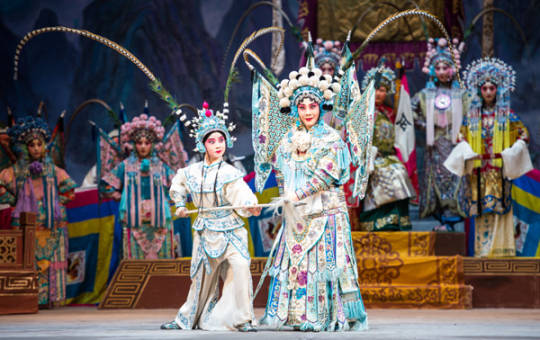
A famous example is the Beijing/Peking Opera, jingju. The makeup and costumes themselves are fantastical representations. The colors and patterns suggest different moods, temperaments, characters, and even changes in emotions. Actors would make distinct movements to depict distinct emotions with varying levels of energy. The stage itself may be sparse, because it is not as important as the expression of emotion and drama.
The stage is sparse not because of the lack of technology or funding, but because it leaves room for the actor themselves to fully express their internal thinking/feeling/emotions. Characters can cross hundreds of miles in a few steps or may take the whole stage to cross a supposed road. This representation looks “unreal” to a realistic-minded audience, but it is very genuine to a Chinese audience.
Summary (so far)
This crucial understanding of the concept of mo (the emotional revelation), and the way traditional Chinese drama depicts life and stories, informs how their modern works are also portrayed. Coming from a Western dramatic background, where realism and plot are the most important aspects of a work, it can be very confusing, right? Even Chinese scholars began to judge their own dramatic works through a Western lens.
How does this traditional background affect modern Chinese dramas and works? I think it still has a very large effect, even though much of Western ideals about dramatic works have been heavily integrated into modern Chinese dramas.
Part 2: On Theatricality and how it transfers into Chinese Cinema
#cdramas#theater#acting style#beijing opera#the untamed#word of honor#kdramas#jdramas#theatricality#east asian cinema
122 notes
·
View notes
Photo
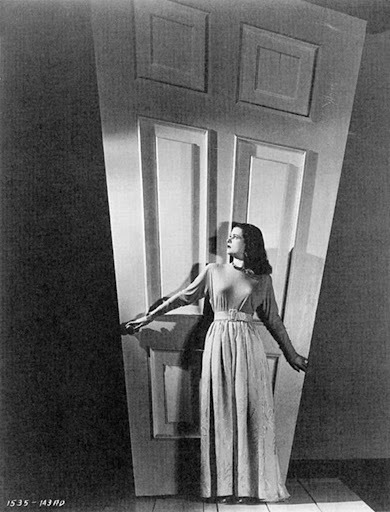
Joan Bennett in the film Secret Behind the Door
Sexuality and Space edited by Beatriz Colomina
Elizabeth Wilson
In the early 1990s the addition of “sexuality” seemed to take the vibrant debate on space into new territory. The very title of Sexuality and Space reflects this, and as Beatriz Colomina remarks in her brief introduction to the collection of articles it comprises, to insist on “sexuality” as a component of space can be, at one level, to insert feminist concerns into a masculine discourse—although it is dispiriting if sexuality is still perceived as women’s domain, somehow suggesting that anatomy still is destiny and/or that women are still equated with the bodily in a way that men are not. As Colomina makes clear, however, the volume, like the symposium at which the papers it contains were initially presented, aims to do more than simply “include women.” Nor does it aim simply to explore “how sexuality acts itself out in space,” although this would have been an interesting subject in its own right: how actually existing urban, architectural spaces are used intentionally or illicitly for sexual purposes. We could have had papers on the role of the “cottage” (public lavatory) in gay sex, on museums as pick-up grounds for intellectual singles, on the voyeurism of peep shows, and so on. But this would presumably have been too literal a project for the theorists gathered. Instead we are invited to treat architecture as a “system of representation” on a par with film and TV, and to ask how space is “already inscribed in the question of sexuality.” Gender is inscribed in space and space is never designed in a gender-neutral way.
Accordingly, the articles range across the visual arts in a fashion that at first glance seems not so much interdisciplinary as wildly eclectic—Atget photographs of Paris, Alberti’s writings, an Australian advertisement for real estate. The approaches taken by the authors are also widely divergent.
Jennifer Bloomer has missed an opportunity to explore the purported “effeminacy” of Louis Henri Sullivan’s architectural work. She raises the interesting issue of the assumed relationship between gender identity (and/or sexual orientation) and allegedly “feminine” architectural forms and decoration, but instead of developing this theme she flirts with it, creating a theoretical bricolage that fails to achieve intellectual coherence, her discussion of the function and symbolic importance of ornament not fully meshing with the problematic figure of Sullivan. A similar collagist approach is used by Catherine Ingraham, and I can see that it may be a kind of postmodern criticism; but while it permits the introduction of a variety of interesting, if only tenuously related, points and theories, it has a modish feel, especially when the usual theoretical suspects are rounded up for an airing, Lacan’s lavatory doors making repeat appearances. By contrast, Alessandra Ponte’s essay on the 18th-century antiquarian Richard Payne Knight is very focused (as is Molly Nesbit’s meditation on the absence of “la Parisienne” from Atget’s photographs of empty corners of his city), a piece of historiographical excavation revealing the phallocentrism of 18th-century theories of architecture.
Yet most of the articles, despite their apparent divergence of subject, are united by theoretical protocols as well as by the central concern of the book as a whole, which is not eroticism but gender, and not architecture but space in a variety of manifestations, many of them historical. The main uniting factor is psychoanalytic theory.
The material throughout is rich and detailed. Beatriz Colomina contributes an analysis of representations of house designs, particularly interiors, by Adolf Loos and Le Corbusier. She explores the way in which these houses are photographed, and some of the ideas informing them, drawing out the way in which these utopian, perfect rooms are—paradoxically—theatrical sets for dramas of domestic life. There is an implied contradiction between the architect’s dream of perfect space and the actually existing mess of daily life; but either way the woman is always positioned as hidden and within, object of the male gaze. Surprising similarities (or perhaps they are not so surprising) are revealed between these modernist architects and the Renaissance architect and philosopher Leon Battista Alberti. Mark Wigley shows how Alberti, both in his treatise on the family and in his architectural writings, describes the ideal house as a building that encloses, conceals, and ultimately fetishizes heterosexual intercourse; the separate rooms of husband and wife may be entered by a private intercommunicating door, so that other members of the household need never know when the partners engage in sexual relations. More generally the domestic interior becomes, in Alberti’s propositions, a prison house for women, although Wigley suggests that this architectural manifestation of patriarchy only fully came into its own with the 19th-century bourgeoisie.
Patricia White’s paper is concerned with the filmic representation of a house, “Hill House,” as explored in Robert Wise’s 1963 horror classic, The Haunting. As she points out, this film is truly terrifying, but achieves its effects without any special effects or any actual representation of anything horrific. White identifies the underlying horror as arising from the film’s exploration of lesbian sexuality, demonstrating convincingly how the film’s central character, Eleanor, played by Julie Harris, although destroyed by Hill House, whose “gaze” she cannot escape, yet manages to “exceed” the narrative, speaking finally in voice-over from beyond the grave. White’s deployment of psychoanalytic film theory seems particularly apt and nonreductive; she uses it to bring out the ambiguity of the film, in which lesbian desire is apparently defeated and yet remains disruptive, “exceeding the drive of cinema to closure.”
Patricia White inevitably refers in the course of her argument to Laura Mulvey’s well-known article “Visual Pleasure and Narrative Cinema.”1 I have never entirely understood why this article became so hugely influential, given its negative and pessimistic reading (especially from a feminist point of view) of cinematic pleasure. But perhaps that was the point: as this volume itself demonstrates, psychoanalytic theory (especially its Lacanian variant) has been the basis for a “criticism of suspicion,” by which I mean a criticism that not only deconstructs the way in which effects are achieved and exposes meanings that might otherwise be hidden from an “innocent” audience, but invests all aspects of any aesthetic work with doubt and dubiousness. The excavation of cultural products must always, it seems, uncover skeletons. In this regard, architecture and cinema are two forms of cultural production particularly vulnerable to what Martin Jay has termed a 20th-century “denigration of vision” that has supplanted its earlier (Enlightenment) celebration.2 Viewing and the gaze, the totalizing vision and the nobility of sight, have been comprehensively delegitimated as (white, Western) masculine methods of control and domination.
In Laura Mulvey’s original article there was no place for the female spectator to lay claim to the gaze other than by becoming masculinized. Mulvey has since sought to modify this view, while never renouncing the underlying assumptions on which it was based, and she contributes to the present volume a meditation that considers Pandora and her box (“the box can … stand as a representation of the enigma and threat generated by the concept of female sexuality in patriarchal culture”), the Hitchcock film Notorious, and the idea of female curiosity as a transgressive exploration of forbidden spaces. For her, psychoanalytic theory as used in feminist criticism is transgressive, for “curiosity describes the desire to know something that is concealed so strongly that it is experienced like a drive, leading to the transgression of a prohibition,” and feminist curiosity then constitutes an unmasking of the patriarchal structures of popular, or indeed any, culture.
Yet, as Victor Burgin argues in his essay on the photography of Helmut Newton, Mulvey’s original article has itself been fetishized; its influence has neither diminished nor evolved. Having made this statement, however, Burgin himself makes little further attempt to develop it, confining himself instead to an analysis of a Newton image, interesting enough, but much narrower in focus than his opening sentence had led this reader, at least, to expect. Burgin is rightly dismissive of the way in which psychoanalytic theory has been “sociologized” and collapsed into a vulgar-Marxist version of woman-as-commodity. He might feel that Lynn Spigel’s essay on television and the postwar American suburban home is too “sociological,” but this is one of the clearest articles in the collection, a model of structural simplicity and accessibility, in which the ambiguity between public and private, outside and inside, created by the plate glass doors and picture windows of the suburban home, is shown to be reproduced by the advent of television with its concomitant notions of the living room as theater and the TV space as a safe, sanitized public space introduced into the home. (Indeed, although television created fears of a new generation of what we now would call “couch potatoes,” the screen community of the sitcom often seemed preferable to the real-life communities of the new suburbs.)
With Elizabeth Grosz’s article on bodies and cities we return to a more euphoric postmodern take on the relationship between sexuality and space. Grosz moves the discussion beyond traditional metaphors of the “body politic” or the humanist idea that at one time people unproblematically built cities; instead she explores the way in which “the city is one of the crucial factors in the social production of (sexed) corporeal bodies: the built environment provides the context … for most contemporary … forms of the body.” But disappointingly she does not develop this idea, falling back instead on a familiar and arguably exaggerated vision of a cyborg future: “the city and body will interface with the computer, forming part of an information machine in which the body’s limbs and organs will become interchangeable parts with the computer.”
Meaghan Morris’s contribution, too dense and theoretically “over-egged” (i.e., incorporating too many ingredients) to summarize, rewards several readings, and is a serious attempt both at a critique of theories and at an analysis of two specific cultural events concerning property speculation in downtown Sydney. It is insightful and thought provoking; nevertheless it illustrates both the virtues and the flaws not just of the book as a whole, but of the general state of cultural studies. Simultaneously populist and obscure, such studies can become both incoherent and philistine (although the latter is certainly not an adjective I would apply to her essay or any of these contributions).
Indeed, this is a (probably rash) generalization, not a comment on any particular article in Sexuality and Space, but if I have seemed to single out some authors for negative criticism, it is less on account of their specific contributions than because they are the heirs of what for me are ambiguous, indeed dubious, tendencies in contemporary cultural criticism, in which the debunking of Marx and all Enlightenment thought is married (or at least engaged) to a fundamentally uncritical appropriation of Freud (or at least Lacan). I have gone terminally off Lacan since I discovered that, when Antonin Artaud was his patient during World War II, Lacan showed little interest in the deranged playwright3; an illegitimate ad hominem argument, I know—but the grip of his theory on academic critics has always been mysterious to me. Even worse is a practice, which I fear may have been on occasion my own, whereby a critic distances herself ironically or cynically from an assortment of postmodern theorists (Baudrillard, Deleuze and Guattari, even Derrida and Foucault) while simultaneously appropriating their thought, not infrequently in the form of spurious generalizations—a feature, Meaghan Morris suggests, of the work of Deleuze and Guattari themselves in relation to Freud. The whole is then likely to be couched in dauntingly arcane and grammatically tortuous language. Faced with this bricolage, I am totally with Edward Gibbon—who identified one aspect of the decline of the Roman Empire as the decadence of its later literary tradition, when, he complained, “a cloud of critics … darkened the face of learning, and the decline of genius was soon followed by the corruption of taste”4—and I cannot but feel that this kind of postmodern criticism is indeed an index of decay.
But I suppose that postmodernism in general and contemporary psychoanalysis in particular is the theory our epoch in history deserves. Psycho-analysis has certainly been reconstructed to fit; in contrast to the highly moralistic and adjustive Freudianism of the 1950s, which was in any case a therapeutic and sociological rather than a critical tool, we have today psychoanalysis as an ideologically empty vessel, a theory without consequences. A fractured body of thought pleasingly open to endless reinterpretations and deconstructions, a detheorized (or perhaps etherealized) theory, it holds up a (splintered, it is true) mirror to assist in the contemplation of ourselves, one which can be thrillingly seen as “transgressive” while remaining devoid of any calls to action or any social or moral imperatives. Truly a theory for our postpolitical times.
1. Laura Mulvey, “Visual Pleasure and Narrative Cinema,” Screen 16, no. 3 (Autumn 1975): 6–18.
2. Martin Jay, “In the Empire of the Gaze: Foucault and the Denigration of Vision in Twentieth Century French Thought,” in David Couzens Hoy, editor, Foucault: A Critical Reader (Oxford: Basil Blackwell, 1986), 178.
3. See Stephen Barber, Antonin Artaud: Blows and Bombs (London: Faber and Faber, 1993).
4. Edward Gibbon, The Decline and Fall of the Roman Empire (Harmondsworth: Penguin, 1985), 83.
Elizabeth Wilson is on the faculty of the School of Information and Communication Studies at the University of North London; her recent books include The Sphinx in the City and Chic Thrills: A Fashion Reader.
#Joan Bennett#Secret Behind the Door#Sexuality and Space#Beatriz Colomina#Elizabeth Wilson#Desire#FIlm#Postmodernism
39 notes
·
View notes
Text
AVATARS OF THE LASTING ASPECTS
Let’s talk about Players and Aspects.
There are Two to Three Avatars of an Aspect, and then the Aspect itself. The two are the Player, and whatever Familiar / Sidekick / Fence / Companion they may have.
The Aspect itself is The Thing and the Whole of the Thing. For example-- you can picture Time without a Player. Its the measurement of events as they proceed; but its also the Begining and the End, the Pace-- Its Art is Music and its Artifact is Clockwork.
Think of all Aspects as like that.
The Avatar of the Aspect, or the Player, is capable of both introducing and controlling how the Aspect will function. If the player chooses bad choices, the Aspect will turn to those bad choices. The Aspect as the Thing and the Whole of the Thing is a neutral force of nature, only following its function, and its Avatar can dictate how that function is carried out. The Avatar and Aspect, however, are separate in this-- the aspect can still carry out its function without an avatar, just look at the Troll-Godless Earth.
The Player’s Class often tells you how the Player will dish out their Aspect.
So.
Why is this important?
Consider what we see in Homestuck.
In the Troll Sessions, the Aspects are balanced. There is an avatar for each aspect, and they carry out as players can and will and won’t to do.
But its the Human sessions where all this gets interesting.
Because the Human sessions aren’t balanced. They don’t have an avatar for each Aspect, and worse still, you can see that a powerful entity-avatar has corrupted the human sessions and one troll session (LE)-- The humans sessions is where it becomes blatant how the Aspects function without someone to direct or with someone with malicious intent.
Let’s start with Beta Session.
Here, we are introduced to Avatars of Breath, Light, Space and Time. Spacetime, its a given we need, because for anything to happen you need Space to fill and Time to pace.
But Light and Breath?
Breath is motion, progression, plot. Everything about the Beta Session is fast moving and constant action, and in fact, is too fast. Everything has to be done quickly, established quicker, and it jumps around.
This is a session without any sort of grounding-- There are no Real Aspects to tie everything down, so everything is all over the place.
Light is Relevance, Meaning and Symbols; Eyes and Color, Consciousness (lights on and everybody is home). There is next to nothing dark about what we’re seeing-- intention is often made plainly clear, most of the characters are in their right minds, and the Beta Session is chocked full of Symbols and Meaning and the promise that things will be made Clear if we can only Look.
But the problem here-- is that its too much all at once. Like above, there are no Real Aspects to ground the Ideals we have. We are given all this information, but have no fucking idea how to process it or where to put it, or what’s relevant to what.
Without Avatars of the Real Aspects (Void, Doom, Blood, Rage, Heart), there is no SENSE. And the Guardians that are there, are just that-- Guardians. They hold an Aspect, but don’t do much with it.
The Aspects that are the Thing and the Whole of the Thing are there, but they merely Are, and do not bend to or over the whims of anyone.
--- Until the Trolls come in, do things start making Sense.
Let’s talk the Alpha Session.
So we have Avatars of Life, Void, Hope, and Heart.
Life is Health, Experience, the Breaking of Impossibility and Normalcy. The Players are Alive, and surprisingly Well, in spite of their awful circumstances. Roxy and Dirk should’ve Died (Dirk fell in the middle of the Ocean as a Baby, how did he survive? Roxy fell in the midst of Carapacians, how was she not Eaten?). And yet, they’re just ordinary teenagers.
But now, the Avatars are forced to live through horrible circumstances. There is no Time or Space-- No way to move forward, and no Space to grow. Just Surviving through all Impossibility-- And its fucking awful.
Hope is Coherence, Belief, Fantasy and Divinity. The fact that the players are experiencing something wholly fantastical-- a literal Alien Empress has come to take over Earth, there are Alien Monsters outside of Jake’s door, their best friends are 500 years into the Future or are in another universe entirely, Apocraplyse and Metaphysical-- That’s a helluva a thing to have.
But now all they have is Hope. Hope that there’s gonna be something better. Hope that something is gonna come down-- and ye gods, that’s awful. They’re living 2020 without it ever being 2020.
And their hope player is a self-serving jackass.
Heart is the Inner Self and Character, the Ego and Persona, the Facet and Aesthetic, Love and Soul and Self. Each character is appropriately theme’d-- Jane is the Heiress to a Cooking Empire and literally acts like the Betty Crocker character we see on the logo (not the Batter Witch). Roxy is a Scientist, and has a Science Lab, and she loves cats and wizards. Jake is a movie enthusiast with a love of adventure, and literally has a Tomb Raider Island just outside his door. And Dirk is surrounded by Robots and Brobots, and quite literal (and distorted) reflections of himself.
And did we mention the Romance Problems.
So many Romance Problems.
Heart here is one of our First Real Aspects. And lot of Dirk’s stress comes from being one of the only Real Aspect Avatars, and trying to temper nearly everyone. Remember that music can be played to the beat of one’s heart-- Heart here is trying to play Time, and uh-- well--
I mean, you tried but...
Void is Irrelevance, the meaningless Physical, the Dark and the Deep, the Incomprehensible. The world is real damn it, and suddenly it doesn’t matter as much anymore. The Session is Void, void of life, void of hope, void of heart, until something comes along and fixes it.
One of the Real Aspects, and it more or less just sits there like a Generic Object. Literally only Roxy is thrilled about this session and for good reason-- she’s the only one in her element. Void fills in what Space doesn’t-- and it doesn’t do that good of a job because NOTHING IS HERE.
... So how many of you called Act 6 meaningless? How many of you had quit ship come Act 6? Feel bored or disappointed? Void did its job, didn’t it.
So.
What about the Aspects that Aren’t here?
Easy, the Trolls fill in what Classes and Aspects are missing. Kanaya brings in Sylph, Karkat Blood, Gamzee Rage and Bard, Sollux Mage and Doom, Terezi Mind, and Vriska brings in Thief (Though it can be argued that Jack Noir originally brought in Thief and Rage).
As an Avatar of Rage, Gamzee is mean to bring Contrivance, Madness and Passion, the Self Evident Truth. The Problem here, is that he only brings in Madness. Take the Juju Episode. He isn’t the Avatar of Rage itself, he’s the Avatar of the Lord of Time’s Rage-- He comes in to do the work of LE, not the work of the real Rage Aspect.
A real avatar of Rage would’ve shown our Alpha Players that they can change the system to favor them-- because this is bullshit.
As Avatar of Mind, Terezi brings in the Outer Self, the Choice, Cause and Effect, Superego and Karma. The Multiverse at your disposal. When she is down because of Gamzee, suddenly you lost all your Choices and there is no Karma (Pre-retcon Meteor).
Mind is also Memory and the Saved Game. If it wasn’t for Terezi, John would not have been able to go back and fix things. For a Narrative, Saved Games aren’t particularly Clean-- But SBURB is also a Game and a Story. We’ve seen what happens when the Player dies and lives are lost-- but imagine if you can just go back to a Saved Game and redo an action without having died in the first place.
That’s Mind.
As Avatar of Blood, Karkat provides not Character-- but You. Your Place, Yourself, Your Choice. Blood is the most Grounded and the Most Real of the Aspects. Everything might be Fake, but You, the Reader, are here and making it real. Blood falls under being Self-Driven, Promises and Friendship, Collective and Shared. Only as strong as your greatest weakness.
When he is down, you’ve lost Everything. When the Avatar of Blood flees, all those bonds and promises go out the window (Murderstuck). When he dies, there is nobody left but despair (Bad End).
As Avatar of Doom, Sollux provides Destruction, The Limit and the Crossed Line, Inevitability and the Impossible-- Death at the End. No matter how bad that seems, Doom isn’t a Bad Aspect. Its the Cleaner. Something has gone wrong, and there’s no way to fix it, you can take solace in the fact that it’ll be over soon. Doom is a very sorrowful aspect, with a thankless but needed job.
He tends to avoid the Human’s (and yet looks up human culture) cos he’s not that interested (Doom avoids the Players). When he’s defeated by the Avatar of Hope, Murderstuck seemingly has no End (and yet, he isn’t dead, just changed). When he leaves to go hang out with Friends once the Humans arrive, Doom has left them (Their journey is guaranteed to succeed).
Sollux has a frightful job, being an Avatar of Doom.
And what of the Muse and the Lord.
Muses are Inspirational. You have something that inspires you to create. Calliope is that inspiration. The Avatar of Space inspires its creation.
And the Lord? Well, he’s the Creator and the Director of the Piece. The Avatar of Time ensures Creation.
Worse though, is when Caliborn proves to be a malicious creator and director, and he literally takes Avatars as his own.
Gamzee, an Avatar of Rage, is now an Avatar of Caliborn’s Rage. His Madness. Spread either via Murderous Intent or Juju.
Equius, an Avatar of Void, is now an Avatar of Caliborn’s Void. His Physical Reality.
Dirk, an Avatar of Heart, fights so hard not to be Caliborn’s Heart. And plenty of Dirk’s other selves Fail this Fight. Bro is merely a distilled version, and that’s horrible enough. Hal fails outright, and his nature tends toward maliciousness toward all other players.
And Homestuck. The Alpha Timeline? -- Its Caliborn’s Time.
And you Will Follow it.
You have no other Choice.
19 notes
·
View notes
Photo

❀ . ━ ❛ ON AERIS’ DESI IDENTITY.
for the sake of making this question easier to answer, I’ll be breaking it up into parts ( yes, i tend to ramble about other things before fully getting to my overall point ). as always, i’m black - not south asian - but i do my best to research before speaking about a culture i do not belong to.
verumking asked : some questions about brown aeris because i'm. forever heart eyes tbh. // you've drawn a lot of parallels between hinduism and the cycle of life on gaia, and also the conflict between aeris' human desires and her duties as a cetra. is her desi identity something she specifically attributes to her cetra heritage? does she begin to embrace it in her day-to-day life at all-- i.e. making and wearing henna, cooking traditional food, etc? how do her views on her identity change with each incarnation?
this is a somewhat difficult question to answer simply because fin.al fa.ntasy often picks and chooses which game is going to be the one™ where the culture and identity of the people within the game actually matters and when it does not ( on a side note: the series in general has a bad habit of using real locations with brown people as inspiration for settings in the game and not reflecting the real people and culture of those locations within the games. half of xii’s party being white people from a desert region literally inspired by the middle east is a glaring example of this ). anyway, i would say vii itself easily places itself within the category of there not being any real sense of culture - or at least nothing of any real substance in my opinion. by that i mean things like how the sector 5 and 7 slums are essentially the same in the remake ( outside of the former being ‘greenier’ ) even though it doesn’t make sense for the equivalent of two mini-cities that are kind of semi-lawless / mostly left to fend for themselves by shinra to not have more of a difference regarding their identities: how they operate, how the people act within them, etc.
there’s also the fact that one of the most well known locations within the game is a christian-styled church within the sector five slums...and yet no religion is ever mentioned within the game’s worldbuilding. the church’s very existence could be seen as ironic if there was actual commentary on humans ( unknowingly ) building a false religion over time as a result of the void created after their ancestors willing choose to abandon their connection to the planet but there isn’t any. humanity, at least within the context of this universe, are essentially treated as the equivalent of atheists that don’t ‘believe’ in the planet being a living organism that deserves to be respected. meanwhile the cetra, the closest thing the game has to a religious group, don’t really seem to follow any specific tenets of a faith outside of protecting the planet and cultivating life on it. basically, i find it weird that a human-made structure and the symbolism that comes with it is imprinted onto aeris of all characters.
on one hand i get the logic behind it: she’s easily the most ‘spiritual’ character of the group ( if not the whole game ) and is canonically white / ’western’ inspired as nom.ura put it so western concepts of what is pure / holy is going to be applied to her from a pure aesthetic standpoint alone. from the church, to her somewhat overused prayer pose™, and her own final limit break which has white angels taken straight out of christian art descend from the heavens in its animation sequence, this specific imagery is given to her a lot - even if it doesn’t make sense from an in-universe perspective. the reason i even bring any of this up is that i think how culture is used and applied to certain characters is already inconsistent which is worth pointing out. aeris’ own identity already clashes with itself in canon - some of it being fully intentional and a part of her arc ( her desires as an individual vs her duty as a cetra ) while some of it ( basically everything stated above ) is...definitely not?
✿ : is her desi identity something she specifically attributes to her cetra heritage?
yes and no. however, before i fully elaborate on why, i have to touch on how i view the cetra as a whole. i’ve always saw them as people who, while nomadic, still have individual ‘tribes’ they belong to / travel with and it would’ve been common for members of one group to branch off and intermingle / travel with another ( or even just travel on their own for a while ). the more the cetra travel and expand their ‘network’ across the entire planet, it’s only natural that groups are going to start forming their own unique differences, whether it’s with looks, how they speak, and their culture, with their bond to the planet and their duty being what ties them all together. the cetra being separated into specific tribes is also directly supported within canon:
ifalna: 2000 years ago, our ancestors, the cetra, heard the cries of the planet. the first ones to discover the planet's wound were the cetra at the knowlespole*.
ifalna: then, just as it had at the knowlespole. it approached other cetra clans...... infecting them with... the virus.
while the cetra capital, the city of the ancients, is in knowlespole ( the modern equivalent of the region that the icicle inn and the northern crater is ), ifalna confirms that other clans beyond it exist. although the details around jenova’s arrival and defeat are unclear, from ifalna’s retelling of what happened ( and her distraught response while doing so ) it seems as if all of the cetra that first encountered jenova were either killed or infected before jenova moved on to do the same to other clans. this more than likely results in entire sub-cultures and histories lost before jenova is sealed away by the cetra aeris descends from ( which would explain why there’s not much recorded information on the cetra within the universe ).
one also has to remember the groups of cetra that branched away from the others and become humans. although they abandoned their duties, it’s very likely that they still retained aspects of cetra culture and it just changed / adapted over a period of two thousand years. with the cetra mostly wiped out and forgotten about, i don’t find it realistic for aeris, at least at the beginning of the game, to really know which ‘parts’ of herself come from where; especially since there would realistically be desi-coded humans that haven’t had ties to the cetra in thousands of years. although i headcanon both her mother and father as brown / desi, aeris doesn’t know who her father, professor gast, even is and the years she spent with her mother were in complete captivity. based on aeris’ ignorance about the white materia ( ex. her thinking it was useless originally ) and the cetra in general, one would assume that ifalna wasn’t able to teach aeris much due to not wanting to reveal anything to shinra since they were likely under constant surveillance. there’s also the fact that aeris outright rejects being a cetra as a child and tries ( yet fails ) to assimilate into ‘human’ culture:
“well…” kyrie replied. “there’s a crumbling church in the slums, where we played together. we did things like pretending to hold wedding ceremonies. aeris was always in the church, taking care of the flowers on her own. sometimes we talked about it. one day, aeris told me to go home quickly. i thought she was being mean because i stepped on her flowers.”
“when i got home in a bad mood, my parent’s bodies were being carried to the house. i heard it from my grandmother. about the lifestream and the ancients. i thought it was just a fairytale at the time, but after that— i figured aeris was an ancient. ...hey, what do you think i said when i met aeris after that? i said ‘you creep me out’.” - kyrie revealing her relationship with aeris after learning of her death in the kids are alright novel.
i guess the real world equivalent of what i’m trying to say would be similar to how i’m black / african american but do i really associate myself and my identity with africa beyond a surface level? the answer is no. how could i when i don’t know anything of my ancestors, african americans are generally robbed of learning about our history, and i don’t even know what ‘part’ of africa i come from. navigating your identity, your culture, and your heritage is extremely complicated and i don’t really see it being any different for aeris. she doesn’t have any way to truly ‘discover’ and connect with her cultural identity - even if she wasn’t actively rejecting it.
✿ : does she begin to embrace it in her day-to-day life at all? i.e. making and wearing henna, cooking traditional food, etc?
she does - although it’s a gradual process that doesn’t start until she leaves midgar. canonically, it’s not even until cosmos canyon that aeris finally begins to ‘connect’ to her heritage and fully understand what it means to be a cetra:
aeris: i learned a lot. the elders taught me many things. about the cetra... and the promised land...i'm...... alone... i'm all alone now...
however, in between chasing sephiroth, almost dying, and then saving the world, she doesn’t have much time to come to terms with everything that she learned there. in my blog canon, she does eventually leave edge a few years after its built to begin traveling on her own and eventually finds herself back in cosmos canyon. realistically, the elders there don’t have all the answers for her but her simply studying there is an important stepping stone to reclaiming a part of herself that she never got to know - or really accepted ( her parents also studied and met there so her life would be coming full circle in a way ).
so with all that said, i see aeris’ ‘embracing’ her desi heritage the most with fashion at first since she technically already does - regardless of whether she realizes it or not. the ultimania for the remake includes concept art for the cetra ( which can be viewed fully here ) and they’re specifically said to have been designed to have similarities to aeris - meaning that aeris’ current style of clothing is meant to embody her ancestors. highlighting a cetra design that looks weirdly similar to aeris herself, this cetra’s outfit - at least to me - feels similar to clothing popular in india and other parts of south asia:

if the dress was taken out and a few alterations was made to her top and half-skirt, it could easily resemble how a lehenga choli piece is worn. the top piece of her half-skirt also resembles the look of an oddiyanam, a type of waist ornament that women in south india wear.

there are other cetra’ accessories that resemble jewelry common in india as well: the armlet on the unnamed cetra resembles a bajuband ( a similar one can be found here ) and bangles similar to a kangan or churi, commonly worn by women across south asia, are prominent in both aeris and the cetra’s overall designs too.
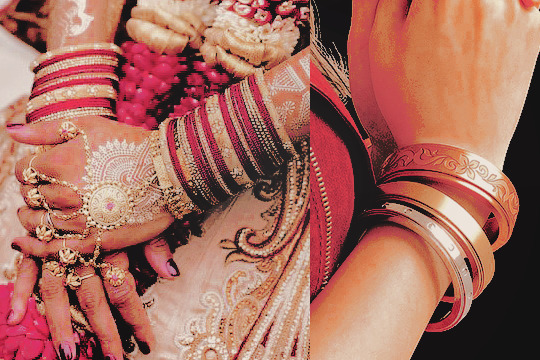
with mehndi / henna, i definitely see her wearing it across her hands and feet but it’s mostly similar to whenever she wears traditional dresses: it’s reserved for special occasions / celebrations. with that said, that’s more so when she’s grown accustomed to applying henna herself without messing up or someone else is doing it for her. it wouldn’t be uncommon to see aeris’ hands decorated with different patterns every few months: a direct result of using her own body as practice when first learning how to draw designs ( if you want to get full fantasy with it, the designs glowing against her skin when she uses magic would be neat ). as a side note: for those who don’t know, there is a short story about aeris’ time in the shinra labs. it contains a drawing by her, which is also in the remake, that has more designs for the cetra ( you can see the unedited version here ):

also aeris cooking? l o l. joking aside, in my three years of writing aeris i’ve never really put much thought into her style of cooking, what type of food she specifically likes to eat, etc. outside of the fact that i don’t think she is much of a cooker at all ( probably because i’m not one either ). however, i cannot let a question go answered so! i’m probably going to sound redundant mentioning cosmos canyon again at this point but it really is due to the fact that it’s specifically the source of her connecting to who she is. the drawing she drew in a trance as a child even includes a location that is more than likely cosmos canyon ( and yes, i checked to compare ). the most notable npcs there are all brown and i do see them all being people of color that have come from different parts of the planet to share knowledge and learn amongst each other. although her main purpose of living in cosmos canyon the years she’s there is to study her people and record her own knowledge ( i’ll touch on this later ), it also provides her with an opportunity to connect with other people that are desi-coded like her on a more personal-level.
am i basically saying she probably tasted some type of chaat ( dahi vada specifically ) for the first time after leaving midgar and never looked back? yes. it’s not until aeris leaves midgar that she gets to experience trying out various food from her own culture as well as food from cultures outside of it in general ( not that these foods didn’t exist in midgar but she’s poor and doesn’t really have the means / opportunity to try them before ). aeris definitely becomes a fan of dishes that are savory with gravy, can be eaten with sauces like chutney ( she likes red chili, spicy coconut and mango chutney the most ), or dishes based around vegetables ( although if there’s spinach it, don’t tell her because ew ), fish or lamb. dishes such as rajma, samosas, sambar, biryani ( it’s probably one of the first desi dishes she would cook on her own ), pakora ( she’s definitely eaten chili pepper pakoras without a sweat ), etc. are all up her alley. aeris admittedly also has a sweet tooth so snacks like kozhukkattai, gulab jamun served with ice cream, etc. also appeals to her greatly™.
the process of eating these dishes when they’re made by other people vs actually introducing them into her day to day eating habits are two different things though. not to say that she wouldn’t make an effort to try - she definitely will but learning how to cook these dishes takes time ( especially if you’re already not much of a cook. ). incorporating them into her daily lifestyle wouldn’t be an instant process but it will happen eventually.
✿ : how do her views on her identity change with each incarnation?
as the embodiment of the lifestream, aeris is constantly consuming information between each reincarnation. the lifestream houses memories and knowledge since the planet’s very inception so she literally has thousands of years of information to sort through and process between each new ‘life’. the different cetra clans that were mentioned earlier? aeris would technically have the ability to trace back the memories of her entire lineage and discover which clan she’s from if she wanted to. with every incarnation, she’s learning a little more about her people, where she comes from, etc. and being a cetra starts to feel like less of a burden to her and a role she starts to embrace / actively take pride in. while there will come a time where she’s not the ‘last cetra’ anymore, aeris essentially becomes an eternal record keeper for her people.
once she begins working with the WRO, it’s actually her idea to start an annual celebration event ( or festival ) during the anniversary of meteorfall. despite her people being nomadic and spread out, the cetra had a capital city and it’s not far fetched to assume that it was used as a place for the cetra to converge during important events, celebrations, etc. through aeris, aspects of their culture begin to live on in new ways such as the meteorfall festival which becomes a celebration of life and the planet itself. while the festival isn’t intended to have any real world parallel, i do think the symbolism of the diwali festival is fitting for the events of sephiroth’s defeat / lifestream and holy destroying meteor:
diwali symbolizes the spiritual victory of light over darkness, good over evil, and knowledge over ignorance.
overall, no matter how many times she reincarnates, aeris always returns to cosmos canyon to record everything she knows, whether its her own life experiences, the memory of her people, or their culture, so that her children, her grandchildren, and so on can always have knowledge of their history and identity in a way that she wasn’t able to.
✿ : brown aeris says thanks for reading!
i hope this was a satisfying answer to your questions! i try to do my best with honoring the cultures i’m talking about and not treating them in a haphazardly and/or lazy way. i wanted to explain her journey of being someone not really connected to their heritage at all and explaining the process she goes through in a realistic way without..making it surface level? hopefully i achieved that!
11 notes
·
View notes
Text
An Essay on the True Nature of Literature.
By Vinay Rajoria

Nobel Prize winning American writer, Ernest Hemingway,writing at his desk.
Looking at a koel bird singing in the hot summer loo or the sprightly squirrel hiding in the pink petals of bougainvillea, I have often wondered what makes me, a mere human, distinct from these other equally alive and walking-talking creatures? At once, a thousand bits and pieces of intriguing answers rush to my mind but when I behold them one by one, then one distinct fact shines more profoundly than others. The fact called culture! In other words, humans unlike other animals are cultured creatures.
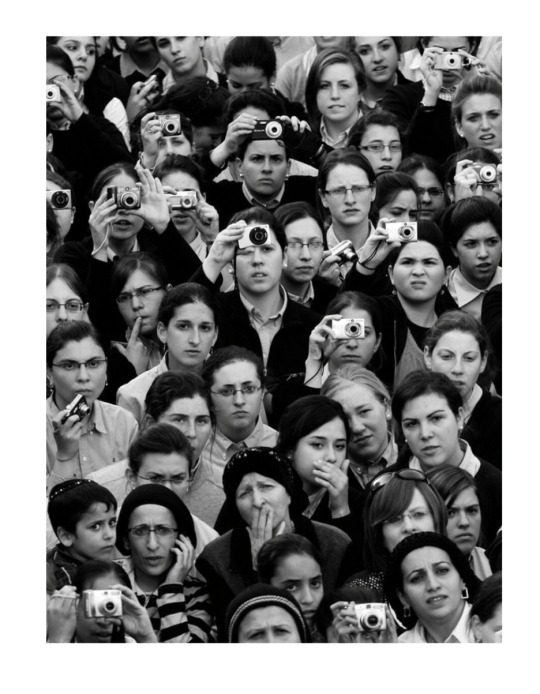
Broadly speaking, a culture is defined as the way of life of a group of people. It has many more complex dimensions but for the sake of this discussion, this will suffice.
Culture includes two parts-material culture and non-material culture. Material culture refers to all the tools, objects, buildings, etc., or in other words every tangible aspect of human creation. But more important to not just the argument of this essay but to the essence of human beings, themselves is the non-material aspect of culture. An aspect that includes the most precious of human resources called ideas and beliefs. This facet of culture is the accumulated knowledge that is learned and passed on from one generation to another.
And it is here, we see the immense importance and almost sheer necessity of the sophisticated tool of communication that humans have developed and perfected over the years, for the efficient transfer of this non-material culture, called language.
Now language, while being a part of the culture, has played and continues to play a vital role in the transmission of ideas. It enables information to be passed from one individual to another, quickly and easily. Initially, this form of effective information transferring was naturally oral, that is information was passed on by the means of different sounds or human voice. This oral tradition to communicate one's thoughts and feelings still continues to exist in the spoken form, but unlike the earlier ages, humans over time developed a new and a much better means of communication which we now call written culture.
It fills me with sheer wonder when I realize how much writing has enhanced the power of sophisticated communication by making information permanently available to others. It has made a thought become almost immortal by making it free from the boundaries of both space and time. With it, anyone can communicate from the deepest of human emotions to the shallowest of political arguments to someone miles away from them, to someone born centuries and centuries after they have gone. In other words, the written word has made the entire corpus of human knowledge, amassed over the years, available to everyone and anyone, just as it was there at the moment of its inception in the mind of its creator.

Now building on this little background of human thought, one can see the question under consideration more effectively. So what is literature? This is a question that evades the exactness of a standard definition so much so that for once it might look like catching moving air with bare hands. But we must keep hope thinking like the German philosopher Nietzsche, who said "and if you gaze long into an abyss, the abyss also gazes into you".

19th-century German philosopher and writer, Friedrich Nietzsche, who wrote the famous book-'Beyond Good &Evil'.
So when you look deep enough, you begin to notice that certain endemic characteristics inherent in all literary works shining out at you. Characteristics that make defining literature a bit easier and propelling us to understand its true nature which makes it distinct from just any written work.
Literature, as I wrote earlier, is about the act of writing itself. It's an integral and a more specialized dimension of the non-material culture. It takes birth from the human desire to express itself in words. And though, it definitely has more nuanced dimensions, but at its very core, it concerns itself primarily about the written existence of thoughts and ideas in the form of symbols called letters.
And it is this cultural influence of the written word which marks the distinction between the languages and dialects spoken around the world; that is languages have their roots and their history in their respective literature. They have the fertile soil of epics and poetry to draw and grow from. Be it then Sanskrit having the texts of Vedas and Upanishads, English having the old English poem Beowulf or Chaucer's Canterbury Tales or the Greeks having Homer's Odyssey and the Iliad, etc. One can even say that more often than not, languages have grown and matured from great works of literature rather than the other way around. As has been the case with Chaucer and the English language, where Chaucer's contribution to the language is so huge that it's rightly said that Chaucer found English as a dialect and left it as a language. Thus, we can say that one of the key characteristics of literature is to give a formal literal structure to the spoken as well written languages. It lends the art of communication a set of well-crafted parameters to look for syntax and aesthetics among other things.
This brings us to another very interesting point that sets literature apart from any written word and that is aesthetics. Literary works be they in any language or culture definitely possess a great amount of aesthetics in themselves. It is this aesthetic sense which the writer builds in his words that makes any normal-sounding conversation or a mundane anecdote of hopelessness spring to life. It makes the writer's personal experience into a social experience which the reader can relate to and imagine as if he or she is experiencing it on its own or in his or her own time. It is the aesthetics of Shakespeare's prose and poetry that make the dilemma of Hamlet or the sorrow of Caesar so impeccable in its appeal, making it count as one of the greatest kinds of literature of the world. One sees this aesthetic characteristic trait in almost every page of the great works of literature of the world, making it stand out as not a sheer amassment of jargon of words or a sentence salad uttered out in a stupor but as a true masterpiece of human genius. Literature hence becomes not just a mere written work but in all true sense a work of art.

Literature,thus,can also be defined as the definitive and controlled expression of human creativity in the form of letters and symbols. In this light, it's actually committing crime to say that any sort of written expression is literature because that means giving no credit whatsoever to the creative process and toil the writer puts in to make his personal raw emotions and ideas into an intelligible and aesthetic creation. A creation which then can be appreciated by the millions and connects us to the mind and the heart of the writer, making us all better human beings in the process because literature, especially great literature for that matter, makes us reflect on the human conscious and suffering which otherwise is so diverse and dynamic and perplexing to comprehend.
Literature, to conclude, then becomes an act of empathy, making us feel the inner and the outer world from someone else's perspective or the act of stepping into someone else's shoes. It makes us come closer to our own psyche and propels us to see the parts of ourselves which we often deliberately choose to ignore. As Emerson rightly said, "In the works of great writers we find our own neglected thoughts."
Image Credits:- Pinterest
References:-
The Glossary of Literary Terms by M.H. Abrams
The Concise History of English literature by William Henry Hudson
The Routledge history of English literature
Follow me on instagram
instagram
Read Next
#criticism#english homework#literature#essays#artwork#photography#portrait#books & libraries#country music#ernest hemingway#art#hogwarts#harry potter#helen fielding#history#hermione#mark darcy#dumbledorequotes#design#john donne#english lit student#england#neitzsche#germany
10 notes
·
View notes
Note
You know, I keep seeing art of Kanna taking Shin's scarf after his death. Which is very cute and heartbreaking! But as that scarf has a lot of emotional baggage, metaphorically chaining Shin to Sou, may I propose an alternative? Kanna with Shin's beanie. Additional bucket is optional.
Dear Anon! Love that you would ask me about this. This is something I think about a lot!
First of all, let me say that I adore all the fan art of Kanna taking Shin’s scarf. It’s an obvious, meaningful way for fans to connect the two characters and their special relationship. I admit that I’m also a huge fan of the scarf itself! It’s such a gorgeous piece of clothing—obviously the nicest thing Shin owns in comparison to the rest of his drab attire. It pops in such a satisfying colorful way.
However, the deeper reason that I love the scarf is because I love Shin himself. I love the scarf because I associate it with him. On a purely visual level, it adds so much spark to his character design.
But the truth behind the scarf is more complicated, isn’t it?
Symbolically, the scarf is Shin's mask. It’s Original Sou’s scarf. It's a bully’s scarf. It’s what Shin uses to hide his kind, vulnerable self. That’s why he’s not wearing it in his redemption when he dies, while he’s clinging to it once again in the route where he lives and swears revenge.
I truly understand why folks would want Shin to leave the scarf to Kanna. (In one of my earliest posts, I even called that idea one of my favorite headcanons.) Because we, as fans, associate that scarf most closely with Shin! It’s the most iconic aspect of his design! And wouldn’t it make sense for Kanna to associate the scarf with Shin too? Wouldn’t it make sense for Kanna to take Shin’s scarf to honor him and show her affection for him, since that scarf was part of how Kanna knew him?
If Kanna and Shin were real people, and if the scarf was a real object, then yes, that would make sense. But they’re literary characters, and the scarf is a symbol.
Symbolically, Kanna cannot take Shin’s scarf.
The irony here is that even though we associate the scarf with Shin, he associates it with Original Sou and their abusive relationship. But we don’t learn the full truth behind the scarf until late in the story.
To be honest, if Kanna innocently took the scarf intending to honor Shin, I believe that she would also grow uncomfortable upon learning the truth. She would have conflicting emotions on whether this was the best way to truly honor someone who sacrificed himself for her. The truth would cut her more deeply than it cuts at us, because Shin/Sou is someone real to her. I think she would still associate the scarf with the man she knew, but the truth complicates everything in the most painful way possible, doesn’t it?
So the things that Kanna takes from Shin in the game’s story aren’t tangible things. She doesn’t get an easy object that she can cling to for courage, like how Shin desperately clung to his old friend’s scarf. Instead, she receives something harder but more important: a lesson. Shin’s lesson to Kanna is that her life has value and she is loved.
I don’t believe that Original Sou gave that lesson to Shin before he passed away. But Our Sou is very different from Original Sou.
Still, it is still natural to want Kanna to have a physical token of her friend, even if the story doesn’t emphasize it. Like the beanie, as you said. (Nankidai even drew Kanna wearing the beanie!)
Actually, if I can get away with a little self-promotion, a user named SarIIon wrote a short sequel to my fanfiction, “Dance Monkey Dance,” in the comments section of my fic in Ao3. They wrote a touching scenario in which Kanna takes Shin’s key necklace! If you’re interested in that sort of thing, or if you already read my fanfiction and liked it, I highly recommend checking the comments and reading it! Since I basically consider it canon for my story, haha.
Just speaking of Shin’s clothes, his key necklace fascinates me! SarIIon and I discussed its possible symbolic meaning in those comments too. To be sure, it is a much more mysterious object than the scarf, and we don’t know the whole truth behind it. But it’s definitely symbolic! Look, maybe my man can’t afford the nicest clothes, but he still dresses himself in literary symbols so he gets to be interesting.
Even if Nankidai doesn’t explain the key necklace, it seems meaningful that Shin kept it hidden behind his scarf. Speaking practically, I believe that it’s what he uses to unlock his collar. But looking at it symbolically, it may be a key meant for himself, for his own heart. As SarIIon beautifully said, “only he had the exit to the Hiyori-shaped box he locked himself within.”
And I believe that the decision to vote for either Sou or Kanna will be the “key” decision in the game. If I’m right on my theory, that necklace may even foreshadow Our Sou ultimately taking the “keymaster” role. Which means that Kanna might take that role in her own route? If she does, and if she continues on her quest to learn more about Shin, then it may make more sense for her to take that necklace after all.
But that’s all headcanon and speculation. In any case…I’m still weak for that scarf’s aesthetic, heh. I’d buy it in a heartbeat.
#your turn to die#yttd#kimi ga shine#sou hiyori#shin tsukimi#kanna kizuchi#your turn to die spoilers#sou and kanna#mine#meta#asks
58 notes
·
View notes
Text
pausing my “”productive”” evening to be briefly insane with rage at this extremely stupid, imprecise, and ignorant essay about garth greenwell and ocean vuong, holy shit, i guess punching down is quite easy when you don’t even feel the need to make a point.
i haven’t finished On Earth We’re Briefly Gorgeous so I cannot speak to that aspect of the essay other than to say 1) the prose is amazing 2) writing to reach someone is the main function of a writer, you need to approach an emotional work in an emotionally open and receptive manner, 3) the critiques of the novel come across as jealous and a purposefully mean spirited reading. however,
if you READ What Belongs to You, if you READ Cleanness, you understand WHY these books are so sincere and WHY there is so much “”gay suffering”” and it is because the narrator fucking hates himself. This is not a secret. Greenwell’s primary aesthetic project in these books is tackling the intersections of shame and desire. What causes intense shame? The fact that the narrator’s father treated him horribly for his entire life because the narrator is sexually attracted to men--and so Greenwell explores gay sex and intimacy. I don’t think this could have been made more apparent? In the middle section of What Belongs to You the narrator reflects on his relationship with his dying father, and begins by discussing the innocent and familial intimacy between the two of them that vanished immediately when the father realized the narrator was gay, as a child.
The narrator is “”sincere”” and confessional about everything as a way to convey the intersections of shame and desire using prose that mirrors the looping, sometimes ponderous thought process of the self loathing. He is capable of reflecting on his terrible qualities and unsafe sexual choices, his obsession with self endangerment through sex and his self blame/culpability, because he thinks there is something not only inherently wrong with him, but inherently unlovable. This is something he obsesses about and it is why partially why the book reads as confessional (the other reason is it is the contemporary modern style. Almost every celebrated litfic novelist is doing it nowadays.) Sex is linked danger, shame, and rejection over and over again for the narrator and he struggles to move on from it because it’s all he thinks he deserves! The craft decision to use sex as a way to explore not just shame/desire but the narrator’s character is incredible! More people should do this! In one of the most harrowing chapters of Cleanness, “Gospodar,” the narrator goes to a professional dom and confesses to wanting to become “nothing.” He explicitly engages in humiliation play. Enough said!
The whole “gay suffering gay man sad” thing is NOT done as suffering for shock value or because it’s a sincere belief in what gay people deserve. This was a common critique of What Belongs to You and I agree it’s thankless to read if you went into it expecting gay Pretty Woman or a happy ending, l m a o, especially since one of the other craft projects of the novel is using Mitko to symbolize Bulgaria post iron curtain/””communism.”” Greenwell then uses Cleanness address the gay suffering critiques by exploring the narrator’s relationship with R....and these chapters are absolutely beautiful and moving and healing for the narrator, he finally gets to say shit like:
“Sex had never been joyful for me before, or almost never, it had always been fraught with shame and anxiety and fear, all of which vanished at the sight of his smile, simply vanished, it poured a cleanness over everything we did” and
“I caught my breath at [something R did for him], I felt a weird pressure and heat climb my throat. I felt like my heart would burst, those were the words for it, the hackneyed phrase, and I was grateful for them, they were a container for what I felt, proof of its commonness. I was grateful for that, too, the commonness of my feeling; I felt some stubborn strangeness in me ease, I felt like part of the human race.”
I don’t think it’s ever confirmed that the narrator in What Belongs to You is the same narrator as Cleanness but I think they must be because of the social implications of cleanness as related to gay sex and to aspects of shame, especially because in part 3 of WBTY the narrator learns he has syphilis, which is a very publicly disfiguring disease if not treated. It’s sexual leprosy, it is disfiguring shame. We read all of Cleanness understanding certain actions he takes as being because of what happened to Mitko, like insisting on condoms. I think the choice of it being syphilis as opposed to AIDs is purposeful but that is another post i will not be making.
The relationship with R is doomed to fail partially because R also experiences immense shame connected to being gay for a different reason and because the narrator is predisposed to self sabotage and other various reasons. It does end, the narrator goes back to his dangerous sexual practices, and Greenwell is careful to show that part of the reason the narrator does this is because he finds social as well as sexual gratification from it. With R the narrator did not do any form of kink except body worship, but body worship is not what the narrator craves because he craves humiliation play! I think the thing that is most interesting about Cleanness in particular is the way it explores different avenues of intimacy, different modes, you can be with someone for a very long time and feel felt and loved and understood and then be with someone else and feel felt and loved and understood in different, equally important ways. Every single relationship in your life is a trade off of these and your own prioritization of your own needs. Greenwell shows that the narrator’s sexual practices and his love for kink is an important need just as it is a self destructive one because of the linking of shame and desire. This is all made explicit in “The Little Saint” (which we are given to understand is post-R) narrator acts as a dom for once and explores being on the other side of the coin. He gets into it and later finds it very upsetting because for him all shame and humiliation is linked to being gay, which circles back to his father, and the sub ends up explaining to the narrator that you don’t have to dominate someone by humiliating them like that. Like what’s not clicking here!!!!!!!
My other main frustrations with this essay are:
the linking of sincerity = gay trauma when good art is often about sincerity and sincerity of emotion, either exploring it or eliciting it, even satire, even fucking...marvel movies, lowest common denominator writing wise, try to make their fans feel something
the fact HE CLEARLY DIDN’T READ THE BOOKS. i know Cleanness is set up as a collection of short stories so you have to take it apart line by line but WBTY is not like that. The shame = bad dad aspect could not have been more clear if it was underlined.
The fact that the essay says Ocean Vuong “is an artist of the memorably obtuse one-liner” as a derogatory thing which is SO rude and comes across as incredibly petty and jealous. Ocean Vuong is a fucking genius. Go after Rupi Kaur if you want to critique a poet who is actually over celebrated, damn
the idea of sincerity = cringe and the inability of many modern critics to moderate their response to a piece of work based on the project or any of its other qualities it is doing instead of like, how it made them feel expressed as sarcastically as possible. I am not a critic but I do not think this is difficult to do. What Belongs to You made me incredibly uncomfortable and sad for much of the book but I was still able to appreciate it? Even when I was like “ahhhhh i hate this” I could understand and appreciate aspects of craft/characterization/emotion/prose/whatever. This is basic shit.
the fact this essay doesn’t even explore the craft genius of Cleanness? it is really subversive to use sex like that in litfic, let alone gay sex...like I understand not liking something just based on your personal tastes but I’m like ?????????? so shocked that the whole craft thing and aesthetic project just doesn’t come up???????? At all?????? ALSO YOU WOULD THINK in an essay that tries to cash in on the outrage of ‘all gay art is suffering’ would explore why the wealthy, straight, white publishing industry and literary elite does invest in gay suffering and the homophobia/history behind it but no! this essay doesn’t even do that!
the fact this got published at all
anyway this essay is stupid and i am stupid for typing up basically an essay about it but like! where else can i do this! if you read all the way to the end pls read Garth Greenwell and Ocean Vuong thanks bye
#i really do not get mad on the internet anymore as a rule but this.....#ugh and what drives me even crazier is i know this stupid fucking essay was published for hate clicks AND IT IS WORKING#garth greenwell#cleanness#homophobia tw#if someone comes to me and says these novels are like toxic and not morally pure uwu i am going to unhinge my jaw and swallow them whole#long post
5 notes
·
View notes
Text
A Bleach Retrospective: In defense of Bleach
These are opinions, please respect that.
_______________________________
My Journey with Bleach (please skip if you want to go straight to the analysis):
On September the 8th, 2006 YTV’s weekend evening anime programming block (Bionix) aired the first episode of Bleach. I, unfortunately, did not catch this episode, instead, I caught the second episode on September 15th the following week. I was ten and from then on, Bleach fascinated me. It had an interesting concept, tight pacing, catchy music, a good story, and unique character designs. I also really enjoyed how Bleach lacked the same kind of emotional labour that Naruto demanded (as child who survived off of constantly seeking validation from others because of absentee parents, Naruto is way too much work).
My fascination with Bleach got me started in the fandom communities of yesteryear, for I was a child with zero internet supervision. My introduction to fanfiction was because I loved Hitsugaya Toshiro.
Bleach was my entry into poetry (poem at the start of every volume).
But alas, all good things were not meant to last and by the summer of 2009, I was officially done with Bleach. It had felt stilted for some time before then. Over the years, I would gradually revisit bits and pieces of Bleach, but I would not read it in its entirety until months after its finish, about a decade after I had first saw Bleach on my TV. Between the time I stopped reading and the series ended, I became friends with people who didn’t think highly of Bleach and I also started seeing criticism I had made about Bleach in 2011 being repeated by fans on the internet, I started to think that maybe Bleach was bad, but I knew what bad writing looked like —I started reading fanfiction through Bleach fanfiction AMVs on YouTube — and somehow Bleach didn’t sit right with me in the “bad writing category”.
I sit back now, a decade and ahalf later from when I first started and ask, “was Bleach really that bad, and if so, why do I keep coming back to it?”
-----------------------------------------------
What Made Bleach So Good?
Unique story and aesthetics: When Bleach first started in 2001, it was one of the first manga series to talk about souls and death in a poetic way and with such coherence. Bleach clearly knew what it wanted to say about life and death. It also had a very unique aesthetic, very similar to that of “The World Ends With You” or “Persona 5″ — an urban Japanese take on R&B kind of vibe. Also, Bleach had the most “realistic” and minimalist art style amongst the Big 3.
Cool Music: Bleach had cool music, from very solid rock’n’roll and R&B style songs in its OPs and EDs to very funky OST music with lots of pizzazz. Many singers feature by Bleach ended up successful (to varying degrees) outside of anime, eg: Orange Range, UVERworld, YUI, sid, etc.
Versatile tone: Bleach was edgy, there’s no doubt about that. It was willing to show a lot of blood and bodily violence, especially in the manga (eg half of people blowing up and bits of bone still attached). Despite this though, it was not pretentious about its edginess — it didn’t revel in it. To contrast the edginess, there is a lot of humour in Bleach with character interactions. It was able to be laid back enough with its strong characters that it would rely on the characters’ relationships for comedic relief. The post-credit skits and the fillers really helped to add to this overall feel as well.
Maturity of the Story: Bleach was very willing to handle topics that made people think. For example, the Ulquiorra - Orihime subarc was treated with a sense of carefulness about it, as if to reflect Ulquiorra’s own cautious curiosity about the heart. A less emotionally mature story would’ve gone for the cheap rape/torture porn, but instead we are treated to determined strong Orihime, who has found strength through the heart after the death of her brother, clashing with the nihilistic hollow who wants to know if there is happiness outside of emptiness. It’s a very loaded question and one that requires both perspective and life experience to fully understand both parties. As well, Bleach always knew what it wanted to say about life and death as the final conflict of Bleach is between Ichigo, who has accepted his transient life and Yhwach, who is scared of death. And ultimately, underneath all that action, Bleach produced takes on its themes that were hard to relate to unless the reader themselves had a certain level of emotional maturity (eg: 12 year old me got nothing out of the Ulqui-Ori arc, but 20 year old me spent a good 10 mins crying after)
Strong characters: Contrary to popular belief, Bleach does have quite solid characterization. In fact, Bleach is the journey of Ichigo as a character, from grappling with his weakness and pain to finally accepting all the parts of himself and his history in order to defeat Yhwach and protect those he cares about. Even the secondary characters of Bleach receive a sizable amount of backstory and/or development. Bleach also managed to have more proactive female characters. Even the damsel in distress Orihime stands up to Ulquiorra and slaps him. As a result of these strong characters, Bleach was able to rely on them and their relationships to drive aspects of the story (eg Ichigo crying in the Fullbringer arc).
Willingness to Deal with Emotion: Given that Ichigo is an internally motivated character, it was obvious Bleach would deal with emotion at some point in time. Making Ichigo just a normal high school boy also relives the previous edginess. Bleach also clearly too the time to make its readers feel in its early years. We are treated to beautiful panelling and very real displays of strong negative emotions. Bleach is also very good at giving its characters room to breathe and be sad. Eg: moping Orihime, moping Ichigo, etc. As well, Kubo went to extraordinary lengths to break Ichigo down during the Fullbringers Arc.
Interesting Character Designs: Every character in Bleach feels vibrant and unique with their personality showing through in their designs. For example: Shunshi’s sloppily tied up hair, visible stubble, and overcoat-hidden-haori show that he is both easy going and not looking for a fight; meanwhile Byakuya’s neatly pulled back hair and neck covered by scarf show that he is both someone who likes structure and is conservative.
Poetry and Symbolism: Kubo manages to weave poetry into Bleach in the beginning of each volume. The poem was said by the character on the volume. It gave the reader insight to this character and it gave Kubo a chance to flex his poetic chops. Further proof of this is the fact that many people don’t realize that the name “Bleach” refers to the bleaching of soul that is key to the story. Kubo loves to use rain to set sad scenes. It rains when Ichigo fights Grand Fisher, Zangetsu tells Ichigo that he hates the rain, etc. Kubo also specifies that he wishes for the reader to read certain volumes on stormy, rainy nights.
Panelling: Many people like to criticize Kubo for the lack of effort with the Bleach manga, but Kubo has stated that he uses negative space (i.e., foregoing backgrounds) to focus more on his character’s expressions. This not only further proves that Bleach cares a lot about its characters, but it’s done well enough that the average reader likely doesn’t notice the lack of background on the first read through. As well, Bleach has very cinematic panelling. Kubo uses the format of manga well, utilizing the human mind’s ability to fill blanks in with clever panelling to create tone and build tension and the feeling of movement through a scene.
In fact, in finding pages for this analysis, I found myself noticing that Bleach panels very similarly to slice-of-life shoujo but with a boy MC manga like "Horimiya": focus on expression through intimate angles and use of panels and breaks to create mood and the feeling of cinema; whereas something like DBZ panels like a shounen action manga with many hard lines and action shots, instead of a focus on subtle details and emotions.
Some Examples:
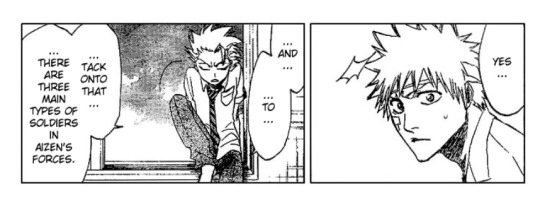

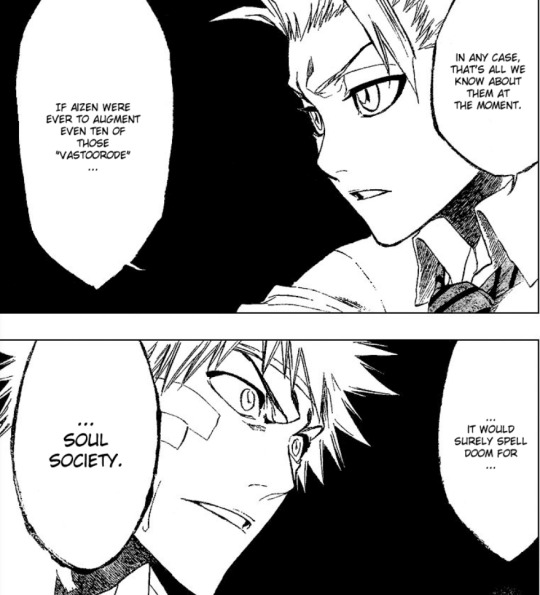
Notice now in Chapter 197: The approaching danger, Kubo uses a gradual zoom to build tension and the black background to add intensity and signal to the reader that Hitsugaya is relaying important information.
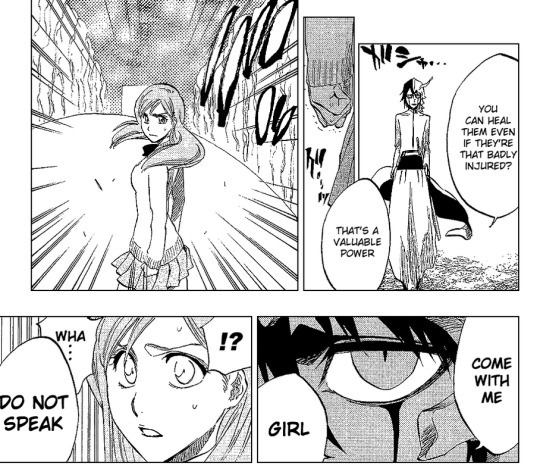
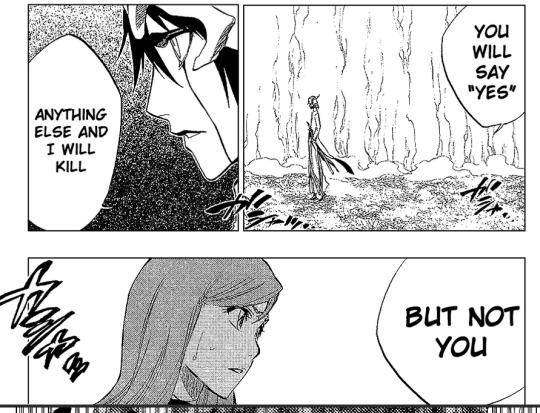
Here in Chapter 234: Not Negotiation, the immediate close up to Ulquiorra’s eye from the full body shots creates a sense of intimidation and unease with its sudden intimacy. As well, the immediate zoom in from Ulquiorra’s side full body shot to his facial profile creates tension and the change from the dark background to the white face with Orihime releases this tension (very fitting with considering the line for this panel is “but not you”). (This scene also ties into Ulquiorra’s central dogma of “that which is not reflected in my eyes does not exist’.)

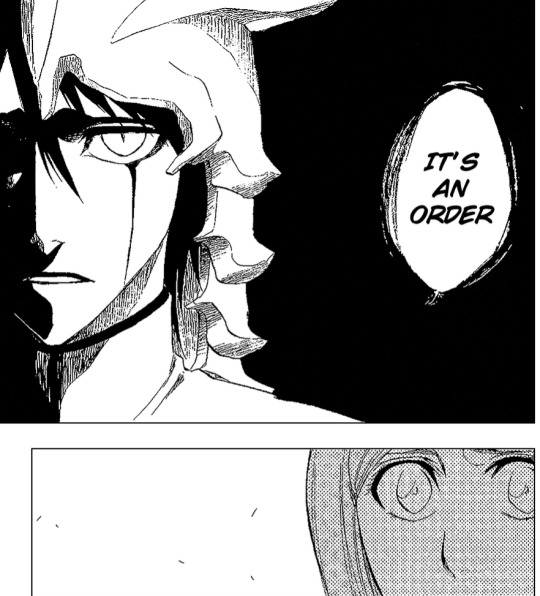
Again in the same chapter, this gradual zoom in on the two creates tension that is then release in the next panel and summarily cements Ulquiorra as a terrifying BAMF.
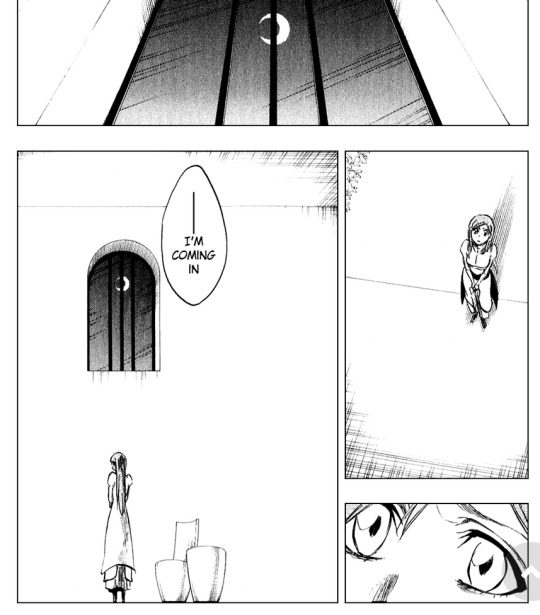
In Chapter 262: Unblendable, Kubo uses the negative space to create a feeling of isolation, similar to how Orihime is supposed to be feeling.
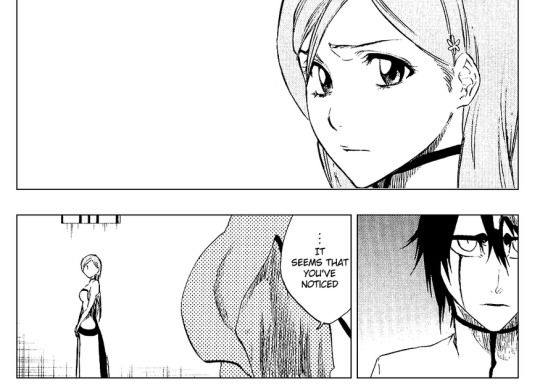

In the same chapter, notice how Kubo creates a sense of intimacy (not in the romance sense) with the relationship of Ulquiorra and Orihime. He creates tension gradually with the zooming into Orihime’s eye and releases it with the zoom out to Ulquiorra. Through this scene, Kubo has shown us that Ulquiorra and Orihime have a tense relationship and with the implication of eye contact through the shots and panel breaks creating both the intimacy and showing Orihime’s defiance.
(Interestingly, I’ve noticed that Ulquiorra and Orihime have a lot of these intimate zoom shot-reverse-shot eye panels)
___________________
What are the Bad Parts of Bleach?
Okay, so by now, you’re probably thinking that I’m ignoring the massive amounts of critique that Bleach gets and don’t get me wrong, while Bleach does have a very special place in my heart, I’m also not maudlin enough to pretend that Bleach was all good.
Pacing:
Pacing in the First Half of Bleach (Karakura Town - Arrancar)
When Bleach first started out the pacing was excellent. Kubo showed great mastery of pace to control the tone and highlight the emotions throughout the first two arcs. Mid-way through the Arrancar arc, the fatigue sets in and it was hard to keep up with, especially since Kubo would interrupt one exciting fight set up to go set up more plot elsewhere (eg Fake Karakura town right as Ichigo and Ulquiorra were about to battle). Whilst looking back and reading it all at once does help with the pacing, it was frustrating if you were reading/watching on a weekly basis.
Pacing in the Anime:
I don’t ascribe to a simplistic belief of “fillers bad” simply because I think that sometimes fillers can be a good thing, for example, since every chapter is ~15-20pp, some character interactions have to be cut for the sake for space, so filler is a great opportunity to add those moments back into your story. For example, a lot of early Bleach fillers are just the people of Karakura town just hanging out. That being said, Bleach does have an unfortunate amount of fillers, with some of them even interrupting tense fights (eg the Beast Sword Arc interrupts Ichigo’s battle with Ulquiorra). However, the padding that the fillers provided did wonders for the transition between Soul Society to Arrancar Arc in the anime. Ultimately, the Bleach anime adaption was a long-running anime made for syndication and that’s okay.
******* Brief Aside: many people like(d?) to point out that Bleach has a very cyclical plot structure. I used to think this way too; however, this is not the case. There are many other long running stories that repeat similar goals. The problem lies not in the idea, but the execution. The main complaint about the Orihime rescue was not that it was uninteresting, but instead that it felt a rehash of the plot of the previous arc. This is largely because the story was not given enough time to breath between similar character arcs. For example, in One Piece, Luffy and Co have to save Nami and by extension, her home village so she can join them; however, the next time a Straw Hat needs to be saved is 227 chapters (2 whole story arcs) later. In between saving Rukia and Orihime, there is only a really an arrancar encounter, a bit of training, cheering up Ichigo, and a Grimmjow encounter before Orihime goes with Ulquiorra, thus making the goal of this arc “save Orihime” in only ~59 chapters vs 227. These two similar arc goals so close to each other does indeed create the sense of repetition.
Pacing from Fullbringer to End:
This is where Bleach really lost a lot of people. If you weren’t gone after the Ulquiorra fight, you probably were by this arc.This arc went at breakneck speed, and ngl, during my first full read through I almost gave up here too. I mention earlier that Ichigo had been broken down in this arc, but it was hard to feel his despair and the weight on his shoulders because there wasn’t enough for the reader to take a beat and breathe. The Thousand Year Blood War, similarly suffered from sloppy pacing, with many readers feeling like story lines of Squad 0 and the Soul King were anti-climactic. As well, this arc started with a massacre and feature the deaths of many fan-favourite characters, and unfortunately due to the pacing, their deaths were not given a sense of gravity.
Missed Opportunities and Forgotten Story lines: Many people felt that Kubo forgot about a lot of his characters after the Aizen arc. Many thought the Fullbringer Arc was going to be a Chad/Orihime Arc. Whatever happened to Uryuu lolol? We all just collectively forgot about him for a large portion of the last half of Bleach. At one point in time, there was a rumour going around that Kubo had written out the story for Bleach and lost it. Idk if there is any credibility to it. However, in a 2017 interview, Kubo did say that he did end the series exactly the way he wanted to.
(If anyone wants to see me write an entire ass text post about Orihime and her treatment in Bleach, please let me know because I will do it)
Too mature:Even though above, I praised Bleach's mature handle on its themes, an unfortunate side effect of this is forgetting that the characters are only 15 at the beginning and for the first half of Bleach. This unfortunately, leads to some readers feeling disconnected from Bleach.
Epilogue: THE DESTROYER OF SHIPS!!! A lot of people hated this ending. Many people felt like the romance was shoe-horned in, others didn’t like the pairings, and there were some people who actually liked it. Personally, I didn’t like it too much, but it was a cute conclusion nonetheless. Since it didn't add anything to the story except for a "where are they now" look and because of that, I low-key felt like it was unnecessary, but w/e.
------------------------
Perspective
Making a long-running weekly serialized story is hard and doing it for 15 years is gruelling (obligatory “fuck capitalism” here). Like many artists of long-running manga, Kubo destroyed his health for the sake of publishing Bleach weekly. Kubo on his health after Bleach (photo from AshitanoGin on Twitter):
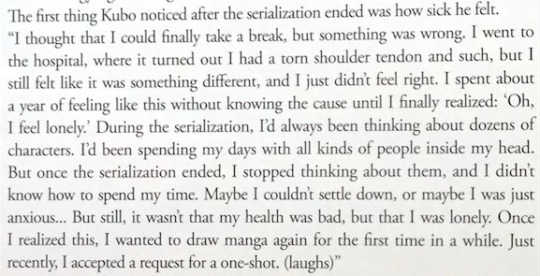
Given this insight, I think it’s only fair to be respectful and grateful for Kubo’s contribution to the anime-sphere. Also, through his work, Kubo seems to be a very understanding person and artist. I’m sure he knows better than anyone where Bleach went wrong, but there’s nothing that can be done now. Despite him having a twitter, he is not Joanne and doesn’t feel the need to constantly hemorrhage out word of god info about Bleach (and thank god for that).
------------------
Final Thoughts
It’s hard to forget my happy memories when I think about Bleach. It had my first adolescent crush and first OTP. As a result, I think the best way to enjoy Bleach is to take what you want out of it. People always think that something has to be 100% without flaw for it to be good, but that is not true at all. It is totally okay to just like the parts that you like without engaging with anything else. It’s special to you for a reason, you know?
There’s no use in fretting over what Bleach could’ve been, besides, very rarely is the reality better than the fantasy in your head.
I do think though that a lot of Kubo’s issues could’ve been fixed if he planned the story better but not all of us can be “I've been planning One Piece since elementary school” Oda Eiichiro.
Other voices on this issue: here
----------------------------
Wow. I can’t believe you made it this far down. Congratulations! Thanks for reading my 2:30am non-sober take on Bleach (it only took me 7 hours to write). Here's a cookie <3
#bleach#pro bleach#analysis#writing#characters#ramblings#pro orihime#orihime#ichigo#ulquiorra cifer#hot take#quarantine thoughts#late night#weebshit#criticism#critique#anime review#manga#i'm still bleach
53 notes
·
View notes
Text
Anime Newbie in her Twenties Ranks her First 10 Anime
With the recommendations of my sister @ging-ler and friends, I started watching anime just over a year ago and within that time I’ve watched a total of 10 - some clocking in at almost 200 episodes and some with only 12. I told myself a while ago that once I had finished 10 anime shows I would rank them like some Anime Newbie WatchMojo list, so, here we are. Really this is just an excuse to force more of my unwarranted opinions onto unwilling followers.
I should also preface this by saying I don’t think any of the anime I watched this year was bad, and I enjoyed a lot about every show even if I ranked some low. However, the top three anime on my list are the ones I would recommend to anyone following me even if they don’t watch anime.
10. Death Note

Despite absolutely loathing the “protagonist” since episode one, I really enjoyed the first half of Death Note! The story was intriguing with all of its wild twist and turns and I found myself immediately invested in what was going to happen next. Unfortunately, after the death of who I thought was by far the best character, the show seems to go off the rails as it introduces new characters and contrived plot devices in the second half that were frankly hard for me to care about at that point. The ending was satisfying but I forced myself to sit through a lot of painful meandering to get there.
9. Cowboy Bebop

Cowboy Bebop was the first anime I watched as suggested to me by @mcsherrybr. The smooth and jazzy art, atmosphere, animation, action, and music were all a lot of fun, as were the lovable ragtag group of misfits that made up the main cast. I enjoyed myself a lot while watching this western/sci-fi melding pot of a show, and I only ranked it so low because the last few episodes were a huge disappointment to my found-family-trope-loving heart.
8. Violet Evergarden
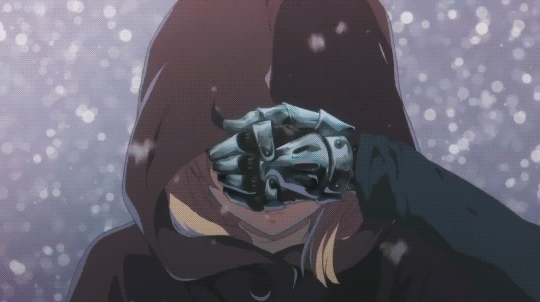
Violet Evergarden, following the story of a child soldier learning to love, is absolutely beautiful to look at and listen to. The music in this anime is, for me, THE best music from any show on this list. This is also the only anime that made me sob several times while watching it. The collection of short episodic stories that explore the deep facets of human love and connection are incredibly resonant and will stay with me for a long time. However, the strength of the small story arcs made the rushed overarching war story and finale weaker in comparison. Similarly, the memorable characters introduced in the one-off side plots were more interesting to me than the cast of rather bland reoccurring supporting characters. While I will remember a lot of great individual moments, I can’t seem to remember a single character’s name besides Violet’s, but that might also be due to being one of the shorter entries at only 12 episodes.
7. Hunter x Hunter (2011)

Going from one of the shortest anime on this list to the longest, Hunter x Hunter was an great and engrossing story during the entirety of its 160+ episodes. It’s colorful and playful, but can also be very dark and at times even heart-wrenching. Because it contains so many distinct arcs, there is a wide variety characters and stories to get attached to, and some, like the Chimera Ant Arc, I even cried over. But this also left me with issues regarding the pacing. The show has great action and introspective moments but will often drag with long drawn-out pauses between fights to explain simple concepts (though I understand that’s a common trope in old shonen anime in general). The world-building is rich but also caught me off guard with some strange ideas, and admittedly not all of them I liked. Some eccentric characters and concepts rubbed me the wrong way and ended up hindering my enjoyment of the show. Overall though, it was a lot of fun and I left with a few more endearing favorite characters, like Leorio and Killua.
6. Erased

Also a 12 episode anime, Erased was amazingly impactful for how short it was. Even as I followed the unfolding murder mystery, I was also touched by the meaningful themes and kind-hearted characters I met along the way. The already-strong story is accentuated with great symbolism, art, and music. The only problem I had was with the mystery itself; I was able to tell who the true killer was within the first 4 episodes, which didn’t lend itself well to suspense and I spent the remaining episodes frustrated that the main characters couldn’t see some obvious clues.This is a minor problem, though, since the finale has less to do with mystery and more about the morals and resolution of themes that I felt was satisfying.
5. Demon Slayer
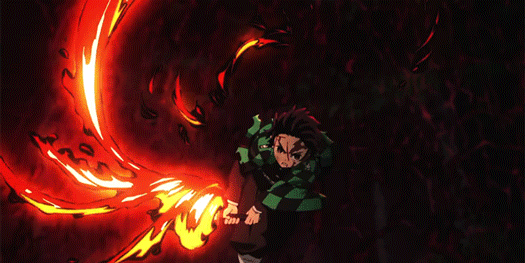
Demon Slayer is gorgeous. The stunning art style, fluid animation, and breath-taking music are all valid reasons to watch it, but the main character Tanjiro and his unwavering devotion to find a cure for his sister-turned-demon Nezuko are the reasons to stay. Tanjiro is unbelievably gentle as he shows even the evil demons he has to slay a hard-fought kindness, and it’s those tender moments between all of the amazing action sequences that really elevate this show for me. The issues I have lie with the rest of the cast. While I love some supporting characters, like the pig-headed Inosuke and the stoic Giyuu, others have very niche personalities that can get annoying if they’re on screen for too long, which they definitely tend to be. Still, the bond between Tanjiro and Nezuko is so strong that it gets me through even those dragging scenes.
And it’s written by a woman!
4. My Hero Academia

Hey so this might come as a shock for anyone who’s followed me for a while: My Hero Academia is not my favorite anime! I do love it a lot - it’s the only anime on this list that has inspired me to read the manga, write fic, and buy merch. There are so many lovable characters and exciting arcs in this show that there is bound to be something for everyone to enjoy, both inside and outside of canon. It’s a wonderfully paced and animated deconstruction of the superhero genre and besides its deeper themes and commentary, there’s also just a lot of endearing teenage goofin’ to be had, and the show balances the tone of these two almost-equally engaging aspects of the story fairly well.
The downside, for me, is the show’s sexualization of female characters, especially the teenagers. With the likes of pervy fellow classmate Mineta, it’s a flaw that’s hard to avoid and takes up an unfortunate amount of screen time. There are in-universe characters that protest against this behavior, and the female characters are still well-written for the most part, but that doesn’t make up for the canon material including it at all. It’s not a huge part of the show but it’s present enough that it really knocks the ranking down for me.
3. Fullmetal Alchemist: Brotherhood
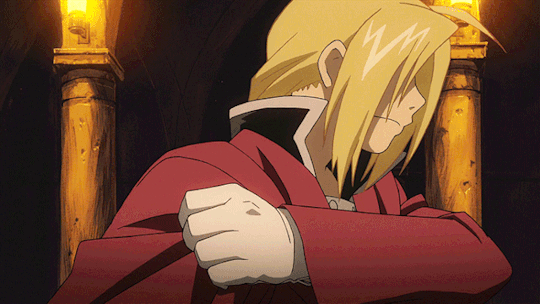
Out of my top 5, Fullmetal Alchemist: Brotherhood is the only one that is complete. Because of that, I can tentatively say that so far, it is the best completed story on this list. From beginning to end, the pacing was perfect - the action never dragged, the characters were never unnecessary, and the plot twists were never unearned. I found myself more invested than I thought I would ever be for the large cast of characters, and everything, including its ending, was satisfying to watch. The animation is fluid and lent itself well to the most impactful scenes, especially involving the flame alchemist Roy Mustang. It’s also written by a woman! Really, the only nitpicks I have were with tonal problems - serious moments would sometimes be ruined by too much slapstick or visual gags.
As I mentioned before, my Top 3 are shows I would recommend to anyone who’s unfamiliar with anime simply because they’re good solid stories with almost no distracting anime tropes. This is a good place to start.
2. The Promised Neverland
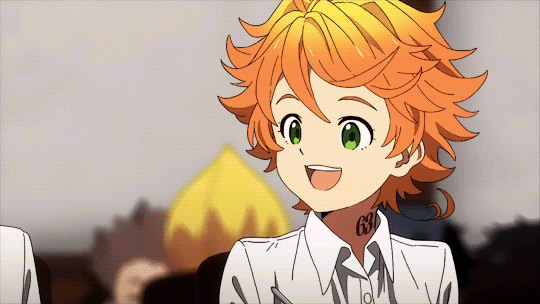
The Promised Neverland is deceiving; on the surface it looks like a sweet show about a bunch of adorable kids playing together in the spacious green backyard of their quaint orphanage. Once you finish the first episode, however, you will quickly discover that there is definitely something more sinister lurking under the surface. This show is an expertly executed dark horror/thriller that always had me on the edge of my seat. The cute aesthetic never distracts from the suspense, in fact, it adds to the discomfort when the horrific visuals and expressions are contrasted against the character designs. I loved all of the characters, including the antagonist, who manages to be just as sympathetic as she is menacing. The sound design and music are also beautiful and adds so much to the rich atmosphere. I am definitely excited to see where this series will go!
1. Mob Psycho 100
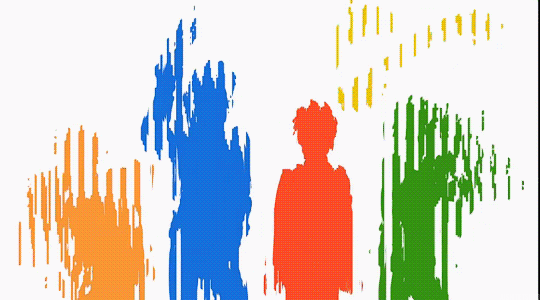
ONE, the creator of Mob Psycho 100, said the single word he used for the concept for the series was “kindness”. Kindness shines through so much of this story following the life of Mob, a super-psychic kid that just wants to fit in, and I adore every second of it. While many shonen anime stories force the child protagonist to get stronger, become more powerful, and fight in battles against hostile adults, Mob Psycho 100 says “that’s stupid. Kids shouldn’t have to be traumatized by immature power-hungry adults. The only strength that anyone should pursue is strength of character, motivated by self-love and love for others.” And it says it with the most beautiful animation I have EVER seen in a show. The simplistic character designs mean the animators can have as much creative freedom as they like with expressions and movement, and they absolutely use that freedom. Humor is a large part of this mostly-comedy anime, but it makes the serious and introspective scenes so much more important when they do happen. The shifts between these two tones never feel awkward or imbalanced.
Mob Psycho 100 has inspired me to become more experimental and joy-seeking with my art, as well as just become a better person in my own life, which I can’t say for many other anime or many other pieces of media period. Even though a Season 3 hasn’t been officially announced yet, I can still safely say Mob Psycho 100 will forever hold a special place in my heart.
22 notes
·
View notes